Cardiovascular Disease as an Alarming Health Issue among Obese Young Adults Population of Australia
VerifiedAdded on 2023/06/11
|20
|4622
|170
AI Summary
This essay analyses the alarming health issue of cardiovascular disease (CVD) among obese young adults population of Australia. It highlights the determinants of health associated with CVD, epidemiological and statistical terms, and a current strategy at the state level.
Contribute Materials
Your contribution can guide someone’s learning journey. Share your
documents today.
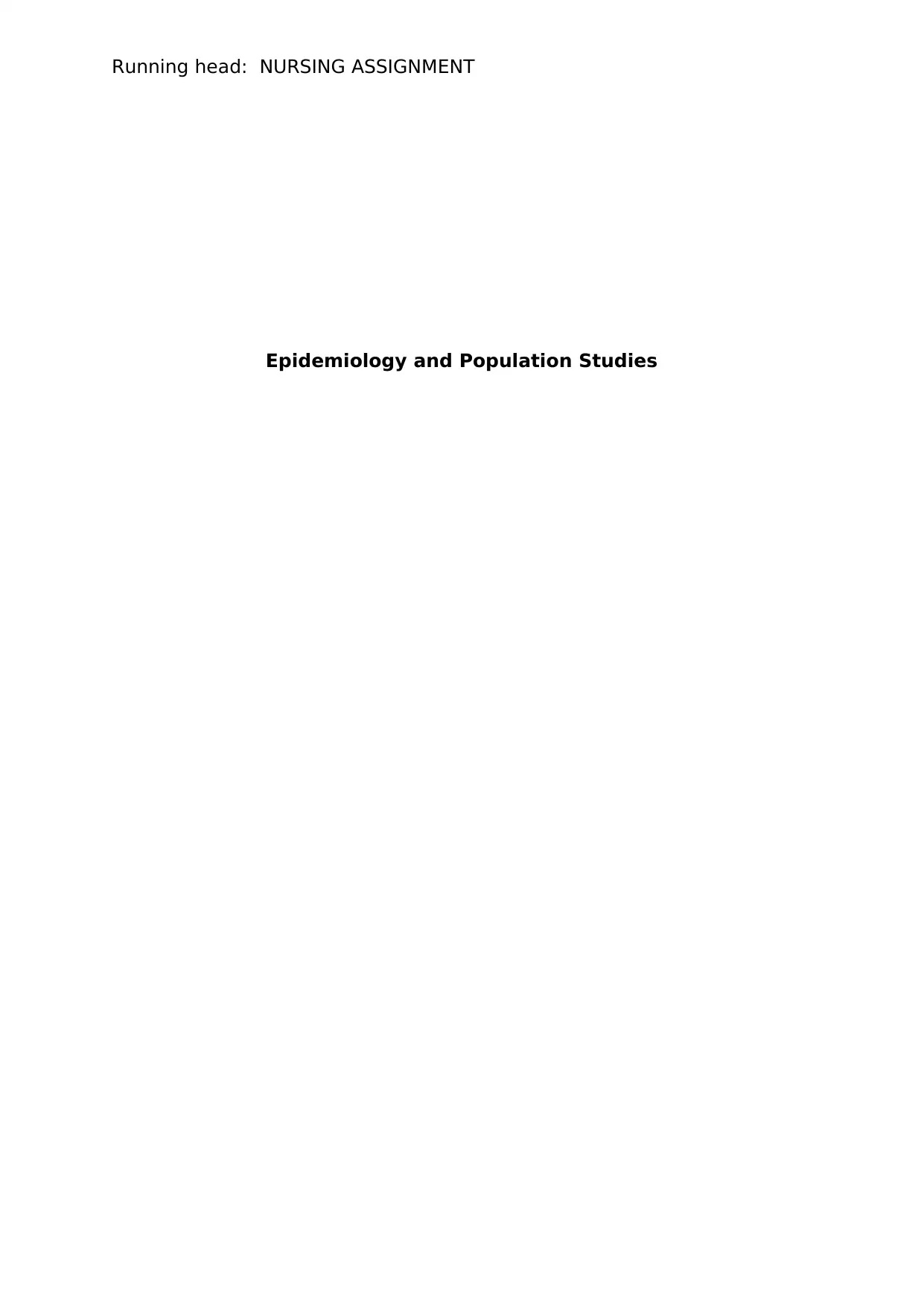
Running head: NURSING ASSIGNMENT
Epidemiology and Population Studies
Epidemiology and Population Studies
Secure Best Marks with AI Grader
Need help grading? Try our AI Grader for instant feedback on your assignments.
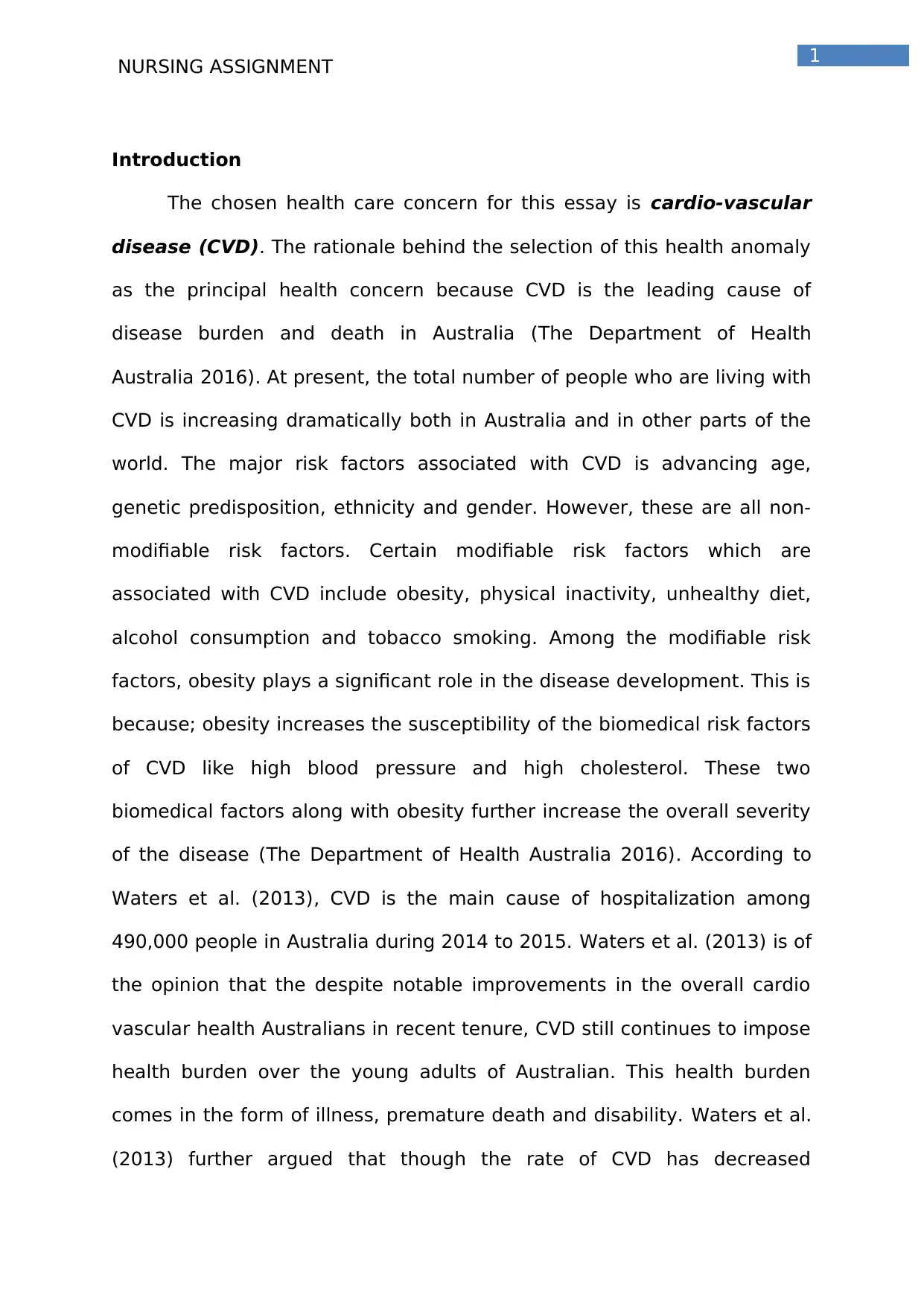
1
NURSING ASSIGNMENT
Introduction
The chosen health care concern for this essay is cardio-vascular
disease (CVD). The rationale behind the selection of this health anomaly
as the principal health concern because CVD is the leading cause of
disease burden and death in Australia (The Department of Health
Australia 2016). At present, the total number of people who are living with
CVD is increasing dramatically both in Australia and in other parts of the
world. The major risk factors associated with CVD is advancing age,
genetic predisposition, ethnicity and gender. However, these are all non-
modifiable risk factors. Certain modifiable risk factors which are
associated with CVD include obesity, physical inactivity, unhealthy diet,
alcohol consumption and tobacco smoking. Among the modifiable risk
factors, obesity plays a significant role in the disease development. This is
because; obesity increases the susceptibility of the biomedical risk factors
of CVD like high blood pressure and high cholesterol. These two
biomedical factors along with obesity further increase the overall severity
of the disease (The Department of Health Australia 2016). According to
Waters et al. (2013), CVD is the main cause of hospitalization among
490,000 people in Australia during 2014 to 2015. Waters et al. (2013) is of
the opinion that the despite notable improvements in the overall cardio
vascular health Australians in recent tenure, CVD still continues to impose
health burden over the young adults of Australian. This health burden
comes in the form of illness, premature death and disability. Waters et al.
(2013) further argued that though the rate of CVD has decreased
NURSING ASSIGNMENT
Introduction
The chosen health care concern for this essay is cardio-vascular
disease (CVD). The rationale behind the selection of this health anomaly
as the principal health concern because CVD is the leading cause of
disease burden and death in Australia (The Department of Health
Australia 2016). At present, the total number of people who are living with
CVD is increasing dramatically both in Australia and in other parts of the
world. The major risk factors associated with CVD is advancing age,
genetic predisposition, ethnicity and gender. However, these are all non-
modifiable risk factors. Certain modifiable risk factors which are
associated with CVD include obesity, physical inactivity, unhealthy diet,
alcohol consumption and tobacco smoking. Among the modifiable risk
factors, obesity plays a significant role in the disease development. This is
because; obesity increases the susceptibility of the biomedical risk factors
of CVD like high blood pressure and high cholesterol. These two
biomedical factors along with obesity further increase the overall severity
of the disease (The Department of Health Australia 2016). According to
Waters et al. (2013), CVD is the main cause of hospitalization among
490,000 people in Australia during 2014 to 2015. Waters et al. (2013) is of
the opinion that the despite notable improvements in the overall cardio
vascular health Australians in recent tenure, CVD still continues to impose
health burden over the young adults of Australian. This health burden
comes in the form of illness, premature death and disability. Waters et al.
(2013) further argued that though the rate of CVD has decreased
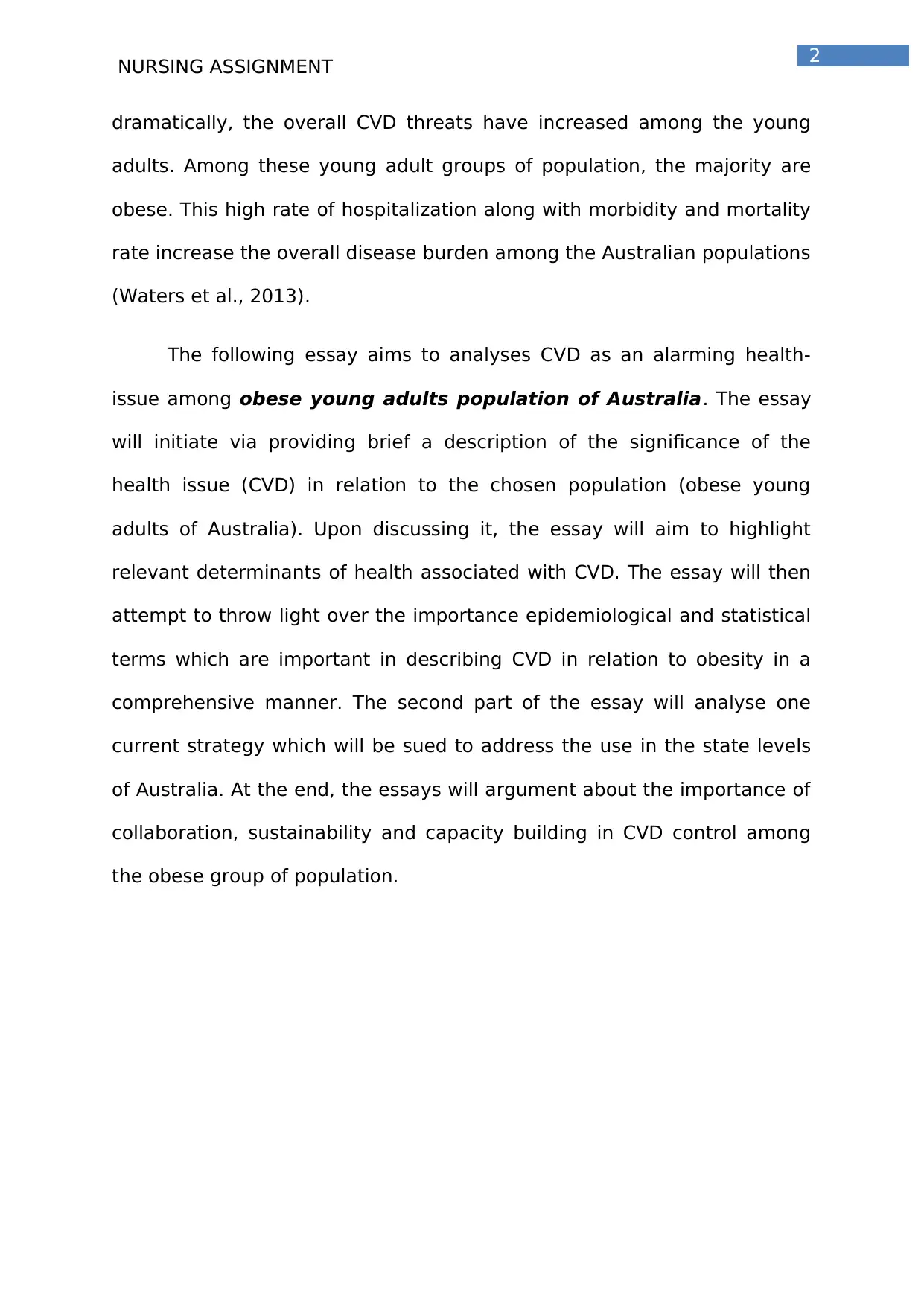
2
NURSING ASSIGNMENT
dramatically, the overall CVD threats have increased among the young
adults. Among these young adult groups of population, the majority are
obese. This high rate of hospitalization along with morbidity and mortality
rate increase the overall disease burden among the Australian populations
(Waters et al., 2013).
The following essay aims to analyses CVD as an alarming health-
issue among obese young adults population of Australia. The essay
will initiate via providing brief a description of the significance of the
health issue (CVD) in relation to the chosen population (obese young
adults of Australia). Upon discussing it, the essay will aim to highlight
relevant determinants of health associated with CVD. The essay will then
attempt to throw light over the importance epidemiological and statistical
terms which are important in describing CVD in relation to obesity in a
comprehensive manner. The second part of the essay will analyse one
current strategy which will be sued to address the use in the state levels
of Australia. At the end, the essays will argument about the importance of
collaboration, sustainability and capacity building in CVD control among
the obese group of population.
NURSING ASSIGNMENT
dramatically, the overall CVD threats have increased among the young
adults. Among these young adult groups of population, the majority are
obese. This high rate of hospitalization along with morbidity and mortality
rate increase the overall disease burden among the Australian populations
(Waters et al., 2013).
The following essay aims to analyses CVD as an alarming health-
issue among obese young adults population of Australia. The essay
will initiate via providing brief a description of the significance of the
health issue (CVD) in relation to the chosen population (obese young
adults of Australia). Upon discussing it, the essay will aim to highlight
relevant determinants of health associated with CVD. The essay will then
attempt to throw light over the importance epidemiological and statistical
terms which are important in describing CVD in relation to obesity in a
comprehensive manner. The second part of the essay will analyse one
current strategy which will be sued to address the use in the state levels
of Australia. At the end, the essays will argument about the importance of
collaboration, sustainability and capacity building in CVD control among
the obese group of population.
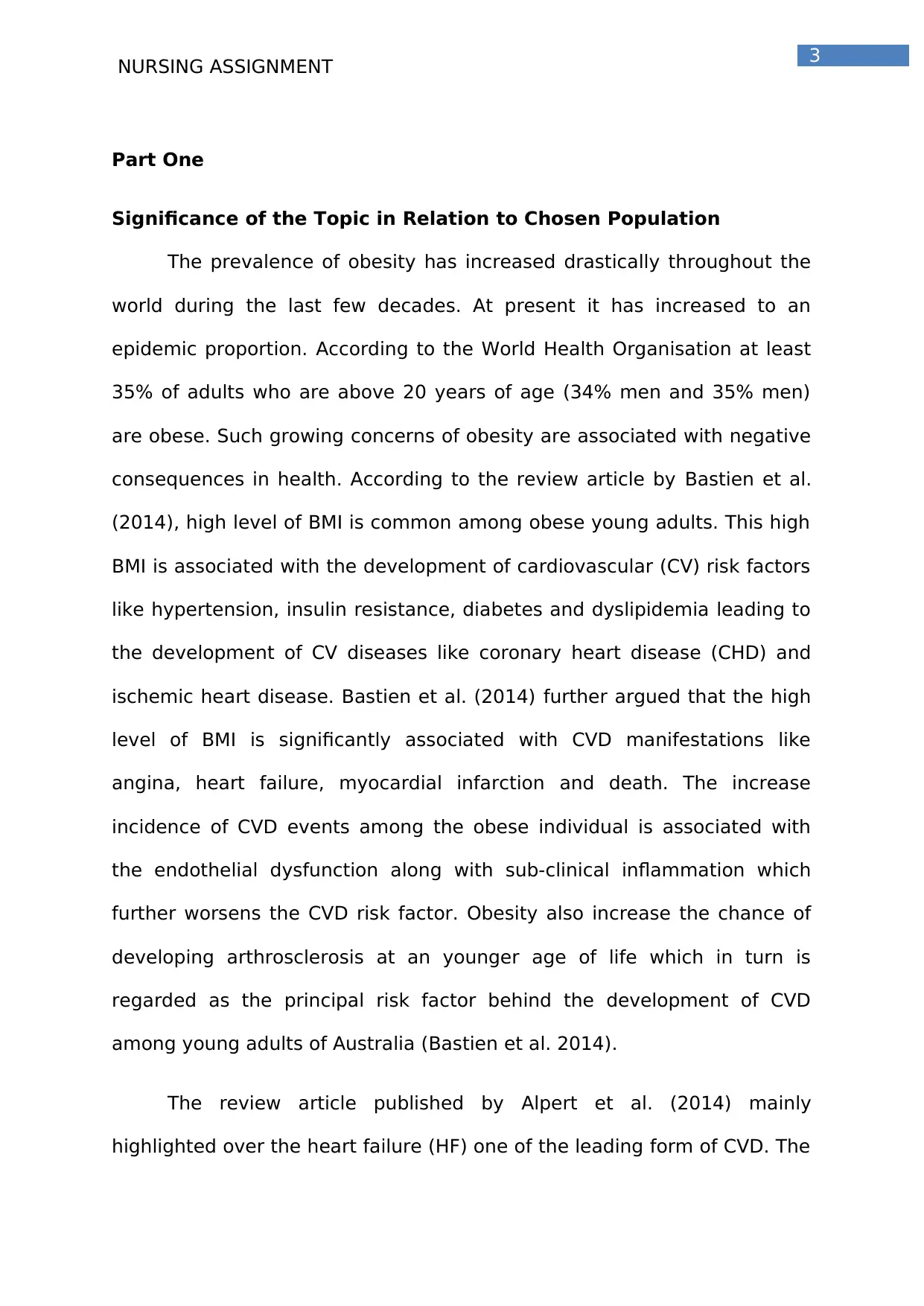
3
NURSING ASSIGNMENT
Part One
Significance of the Topic in Relation to Chosen Population
The prevalence of obesity has increased drastically throughout the
world during the last few decades. At present it has increased to an
epidemic proportion. According to the World Health Organisation at least
35% of adults who are above 20 years of age (34% men and 35% men)
are obese. Such growing concerns of obesity are associated with negative
consequences in health. According to the review article by Bastien et al.
(2014), high level of BMI is common among obese young adults. This high
BMI is associated with the development of cardiovascular (CV) risk factors
like hypertension, insulin resistance, diabetes and dyslipidemia leading to
the development of CV diseases like coronary heart disease (CHD) and
ischemic heart disease. Bastien et al. (2014) further argued that the high
level of BMI is significantly associated with CVD manifestations like
angina, heart failure, myocardial infarction and death. The increase
incidence of CVD events among the obese individual is associated with
the endothelial dysfunction along with sub-clinical inflammation which
further worsens the CVD risk factor. Obesity also increase the chance of
developing arthrosclerosis at an younger age of life which in turn is
regarded as the principal risk factor behind the development of CVD
among young adults of Australia (Bastien et al. 2014).
The review article published by Alpert et al. (2014) mainly
highlighted over the heart failure (HF) one of the leading form of CVD. The
NURSING ASSIGNMENT
Part One
Significance of the Topic in Relation to Chosen Population
The prevalence of obesity has increased drastically throughout the
world during the last few decades. At present it has increased to an
epidemic proportion. According to the World Health Organisation at least
35% of adults who are above 20 years of age (34% men and 35% men)
are obese. Such growing concerns of obesity are associated with negative
consequences in health. According to the review article by Bastien et al.
(2014), high level of BMI is common among obese young adults. This high
BMI is associated with the development of cardiovascular (CV) risk factors
like hypertension, insulin resistance, diabetes and dyslipidemia leading to
the development of CV diseases like coronary heart disease (CHD) and
ischemic heart disease. Bastien et al. (2014) further argued that the high
level of BMI is significantly associated with CVD manifestations like
angina, heart failure, myocardial infarction and death. The increase
incidence of CVD events among the obese individual is associated with
the endothelial dysfunction along with sub-clinical inflammation which
further worsens the CVD risk factor. Obesity also increase the chance of
developing arthrosclerosis at an younger age of life which in turn is
regarded as the principal risk factor behind the development of CVD
among young adults of Australia (Bastien et al. 2014).
The review article published by Alpert et al. (2014) mainly
highlighted over the heart failure (HF) one of the leading form of CVD. The
Secure Best Marks with AI Grader
Need help grading? Try our AI Grader for instant feedback on your assignments.
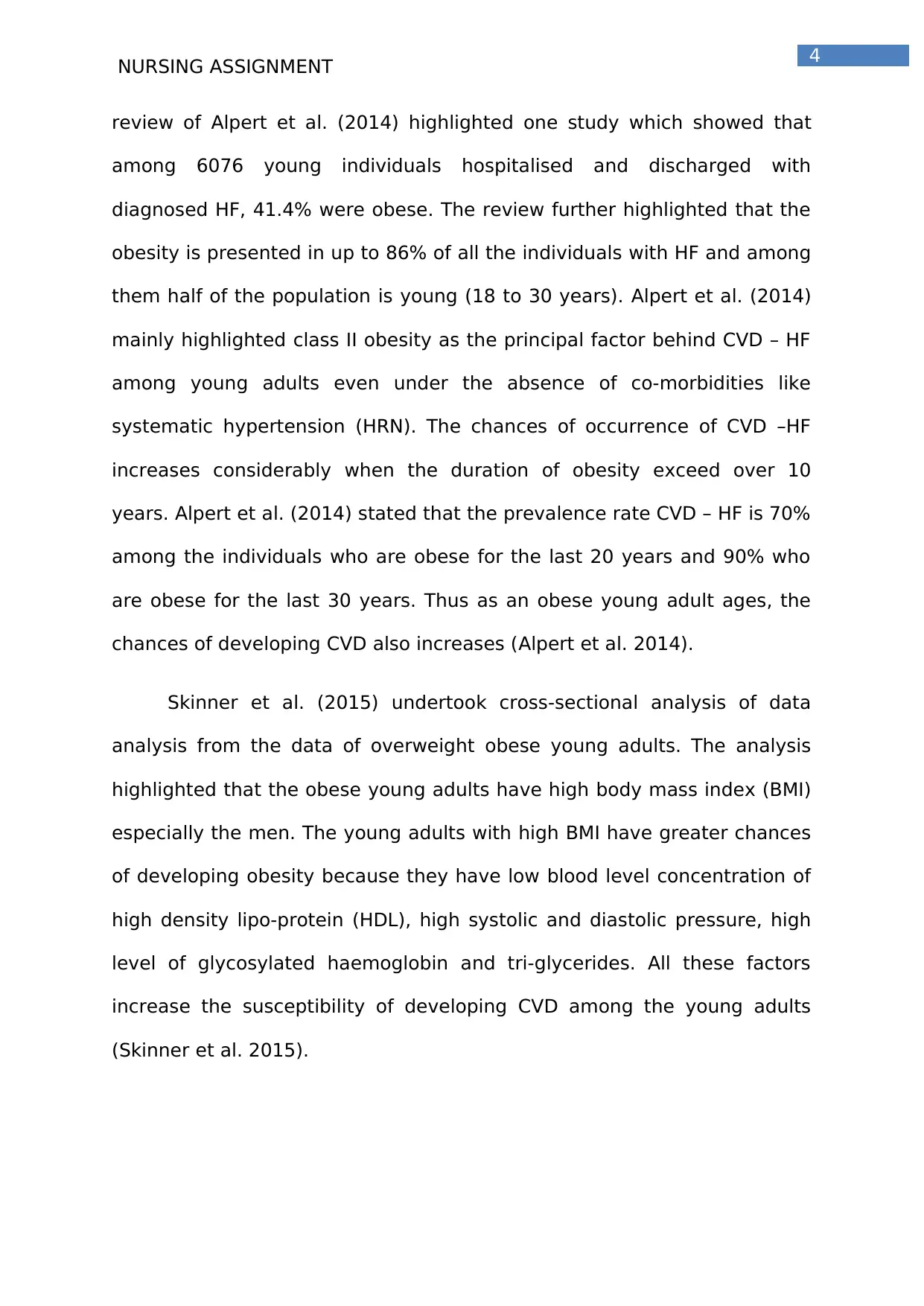
4
NURSING ASSIGNMENT
review of Alpert et al. (2014) highlighted one study which showed that
among 6076 young individuals hospitalised and discharged with
diagnosed HF, 41.4% were obese. The review further highlighted that the
obesity is presented in up to 86% of all the individuals with HF and among
them half of the population is young (18 to 30 years). Alpert et al. (2014)
mainly highlighted class II obesity as the principal factor behind CVD – HF
among young adults even under the absence of co-morbidities like
systematic hypertension (HRN). The chances of occurrence of CVD –HF
increases considerably when the duration of obesity exceed over 10
years. Alpert et al. (2014) stated that the prevalence rate CVD – HF is 70%
among the individuals who are obese for the last 20 years and 90% who
are obese for the last 30 years. Thus as an obese young adult ages, the
chances of developing CVD also increases (Alpert et al. 2014).
Skinner et al. (2015) undertook cross-sectional analysis of data
analysis from the data of overweight obese young adults. The analysis
highlighted that the obese young adults have high body mass index (BMI)
especially the men. The young adults with high BMI have greater chances
of developing obesity because they have low blood level concentration of
high density lipo-protein (HDL), high systolic and diastolic pressure, high
level of glycosylated haemoglobin and tri-glycerides. All these factors
increase the susceptibility of developing CVD among the young adults
(Skinner et al. 2015).
NURSING ASSIGNMENT
review of Alpert et al. (2014) highlighted one study which showed that
among 6076 young individuals hospitalised and discharged with
diagnosed HF, 41.4% were obese. The review further highlighted that the
obesity is presented in up to 86% of all the individuals with HF and among
them half of the population is young (18 to 30 years). Alpert et al. (2014)
mainly highlighted class II obesity as the principal factor behind CVD – HF
among young adults even under the absence of co-morbidities like
systematic hypertension (HRN). The chances of occurrence of CVD –HF
increases considerably when the duration of obesity exceed over 10
years. Alpert et al. (2014) stated that the prevalence rate CVD – HF is 70%
among the individuals who are obese for the last 20 years and 90% who
are obese for the last 30 years. Thus as an obese young adult ages, the
chances of developing CVD also increases (Alpert et al. 2014).
Skinner et al. (2015) undertook cross-sectional analysis of data
analysis from the data of overweight obese young adults. The analysis
highlighted that the obese young adults have high body mass index (BMI)
especially the men. The young adults with high BMI have greater chances
of developing obesity because they have low blood level concentration of
high density lipo-protein (HDL), high systolic and diastolic pressure, high
level of glycosylated haemoglobin and tri-glycerides. All these factors
increase the susceptibility of developing CVD among the young adults
(Skinner et al. 2015).
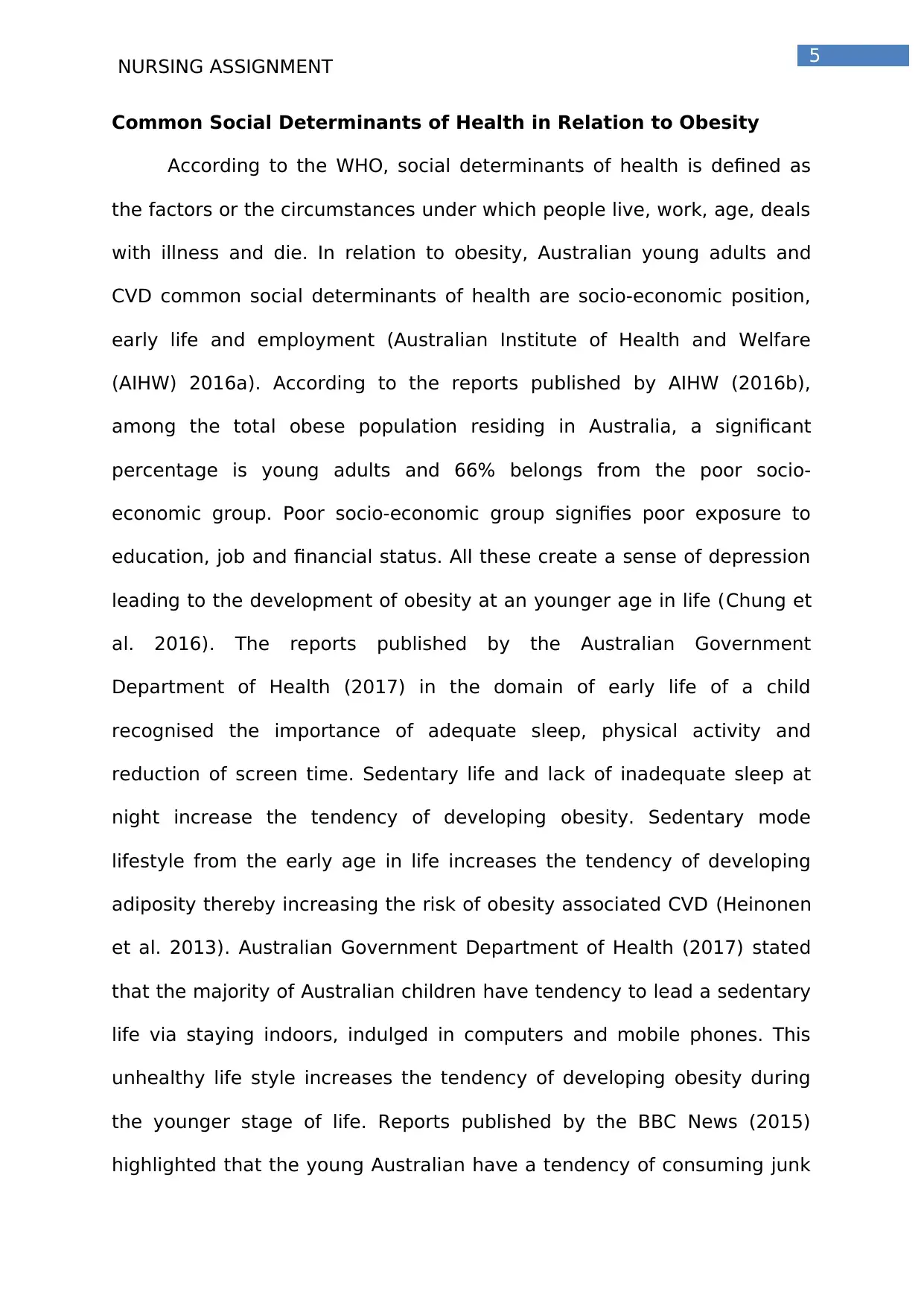
5
NURSING ASSIGNMENT
Common Social Determinants of Health in Relation to Obesity
According to the WHO, social determinants of health is defined as
the factors or the circumstances under which people live, work, age, deals
with illness and die. In relation to obesity, Australian young adults and
CVD common social determinants of health are socio-economic position,
early life and employment (Australian Institute of Health and Welfare
(AIHW) 2016a). According to the reports published by AIHW (2016b),
among the total obese population residing in Australia, a significant
percentage is young adults and 66% belongs from the poor socio-
economic group. Poor socio-economic group signifies poor exposure to
education, job and financial status. All these create a sense of depression
leading to the development of obesity at an younger age in life (Chung et
al. 2016). The reports published by the Australian Government
Department of Health (2017) in the domain of early life of a child
recognised the importance of adequate sleep, physical activity and
reduction of screen time. Sedentary life and lack of inadequate sleep at
night increase the tendency of developing obesity. Sedentary mode
lifestyle from the early age in life increases the tendency of developing
adiposity thereby increasing the risk of obesity associated CVD (Heinonen
et al. 2013). Australian Government Department of Health (2017) stated
that the majority of Australian children have tendency to lead a sedentary
life via staying indoors, indulged in computers and mobile phones. This
unhealthy life style increases the tendency of developing obesity during
the younger stage of life. Reports published by the BBC News (2015)
highlighted that the young Australian have a tendency of consuming junk
NURSING ASSIGNMENT
Common Social Determinants of Health in Relation to Obesity
According to the WHO, social determinants of health is defined as
the factors or the circumstances under which people live, work, age, deals
with illness and die. In relation to obesity, Australian young adults and
CVD common social determinants of health are socio-economic position,
early life and employment (Australian Institute of Health and Welfare
(AIHW) 2016a). According to the reports published by AIHW (2016b),
among the total obese population residing in Australia, a significant
percentage is young adults and 66% belongs from the poor socio-
economic group. Poor socio-economic group signifies poor exposure to
education, job and financial status. All these create a sense of depression
leading to the development of obesity at an younger age in life (Chung et
al. 2016). The reports published by the Australian Government
Department of Health (2017) in the domain of early life of a child
recognised the importance of adequate sleep, physical activity and
reduction of screen time. Sedentary life and lack of inadequate sleep at
night increase the tendency of developing obesity. Sedentary mode
lifestyle from the early age in life increases the tendency of developing
adiposity thereby increasing the risk of obesity associated CVD (Heinonen
et al. 2013). Australian Government Department of Health (2017) stated
that the majority of Australian children have tendency to lead a sedentary
life via staying indoors, indulged in computers and mobile phones. This
unhealthy life style increases the tendency of developing obesity during
the younger stage of life. Reports published by the BBC News (2015)
highlighted that the young Australian have a tendency of consuming junk
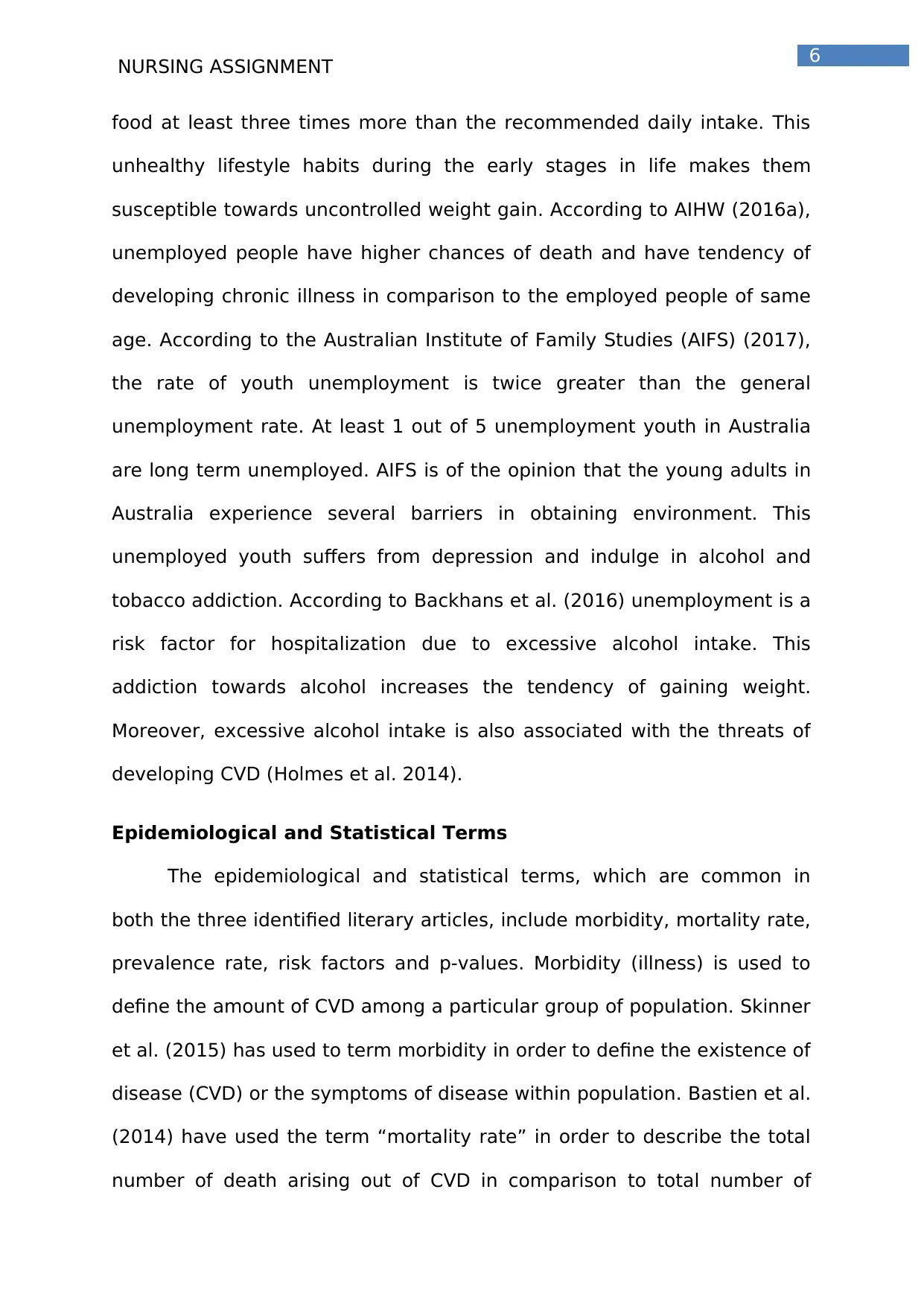
6
NURSING ASSIGNMENT
food at least three times more than the recommended daily intake. This
unhealthy lifestyle habits during the early stages in life makes them
susceptible towards uncontrolled weight gain. According to AIHW (2016a),
unemployed people have higher chances of death and have tendency of
developing chronic illness in comparison to the employed people of same
age. According to the Australian Institute of Family Studies (AIFS) (2017),
the rate of youth unemployment is twice greater than the general
unemployment rate. At least 1 out of 5 unemployment youth in Australia
are long term unemployed. AIFS is of the opinion that the young adults in
Australia experience several barriers in obtaining environment. This
unemployed youth suffers from depression and indulge in alcohol and
tobacco addiction. According to Backhans et al. (2016) unemployment is a
risk factor for hospitalization due to excessive alcohol intake. This
addiction towards alcohol increases the tendency of gaining weight.
Moreover, excessive alcohol intake is also associated with the threats of
developing CVD (Holmes et al. 2014).
Epidemiological and Statistical Terms
The epidemiological and statistical terms, which are common in
both the three identified literary articles, include morbidity, mortality rate,
prevalence rate, risk factors and p-values. Morbidity (illness) is used to
define the amount of CVD among a particular group of population. Skinner
et al. (2015) has used to term morbidity in order to define the existence of
disease (CVD) or the symptoms of disease within population. Bastien et al.
(2014) have used the term “mortality rate” in order to describe the total
number of death arising out of CVD in comparison to total number of
NURSING ASSIGNMENT
food at least three times more than the recommended daily intake. This
unhealthy lifestyle habits during the early stages in life makes them
susceptible towards uncontrolled weight gain. According to AIHW (2016a),
unemployed people have higher chances of death and have tendency of
developing chronic illness in comparison to the employed people of same
age. According to the Australian Institute of Family Studies (AIFS) (2017),
the rate of youth unemployment is twice greater than the general
unemployment rate. At least 1 out of 5 unemployment youth in Australia
are long term unemployed. AIFS is of the opinion that the young adults in
Australia experience several barriers in obtaining environment. This
unemployed youth suffers from depression and indulge in alcohol and
tobacco addiction. According to Backhans et al. (2016) unemployment is a
risk factor for hospitalization due to excessive alcohol intake. This
addiction towards alcohol increases the tendency of gaining weight.
Moreover, excessive alcohol intake is also associated with the threats of
developing CVD (Holmes et al. 2014).
Epidemiological and Statistical Terms
The epidemiological and statistical terms, which are common in
both the three identified literary articles, include morbidity, mortality rate,
prevalence rate, risk factors and p-values. Morbidity (illness) is used to
define the amount of CVD among a particular group of population. Skinner
et al. (2015) has used to term morbidity in order to define the existence of
disease (CVD) or the symptoms of disease within population. Bastien et al.
(2014) have used the term “mortality rate” in order to describe the total
number of death arising out of CVD in comparison to total number of
Paraphrase This Document
Need a fresh take? Get an instant paraphrase of this document with our AI Paraphraser
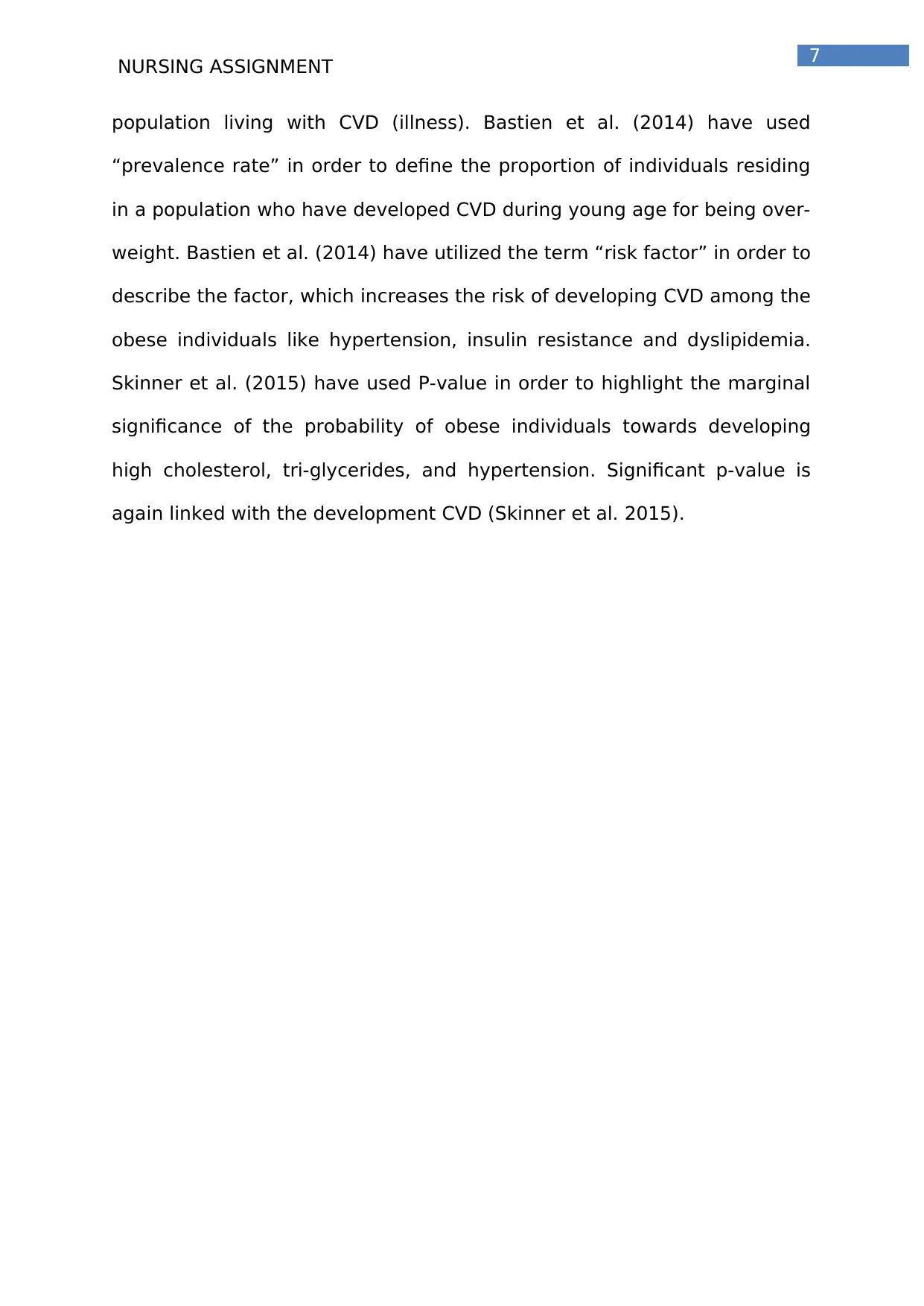
7
NURSING ASSIGNMENT
population living with CVD (illness). Bastien et al. (2014) have used
“prevalence rate” in order to define the proportion of individuals residing
in a population who have developed CVD during young age for being over-
weight. Bastien et al. (2014) have utilized the term “risk factor” in order to
describe the factor, which increases the risk of developing CVD among the
obese individuals like hypertension, insulin resistance and dyslipidemia.
Skinner et al. (2015) have used P-value in order to highlight the marginal
significance of the probability of obese individuals towards developing
high cholesterol, tri-glycerides, and hypertension. Significant p-value is
again linked with the development CVD (Skinner et al. 2015).
NURSING ASSIGNMENT
population living with CVD (illness). Bastien et al. (2014) have used
“prevalence rate” in order to define the proportion of individuals residing
in a population who have developed CVD during young age for being over-
weight. Bastien et al. (2014) have utilized the term “risk factor” in order to
describe the factor, which increases the risk of developing CVD among the
obese individuals like hypertension, insulin resistance and dyslipidemia.
Skinner et al. (2015) have used P-value in order to highlight the marginal
significance of the probability of obese individuals towards developing
high cholesterol, tri-glycerides, and hypertension. Significant p-value is
again linked with the development CVD (Skinner et al. 2015).
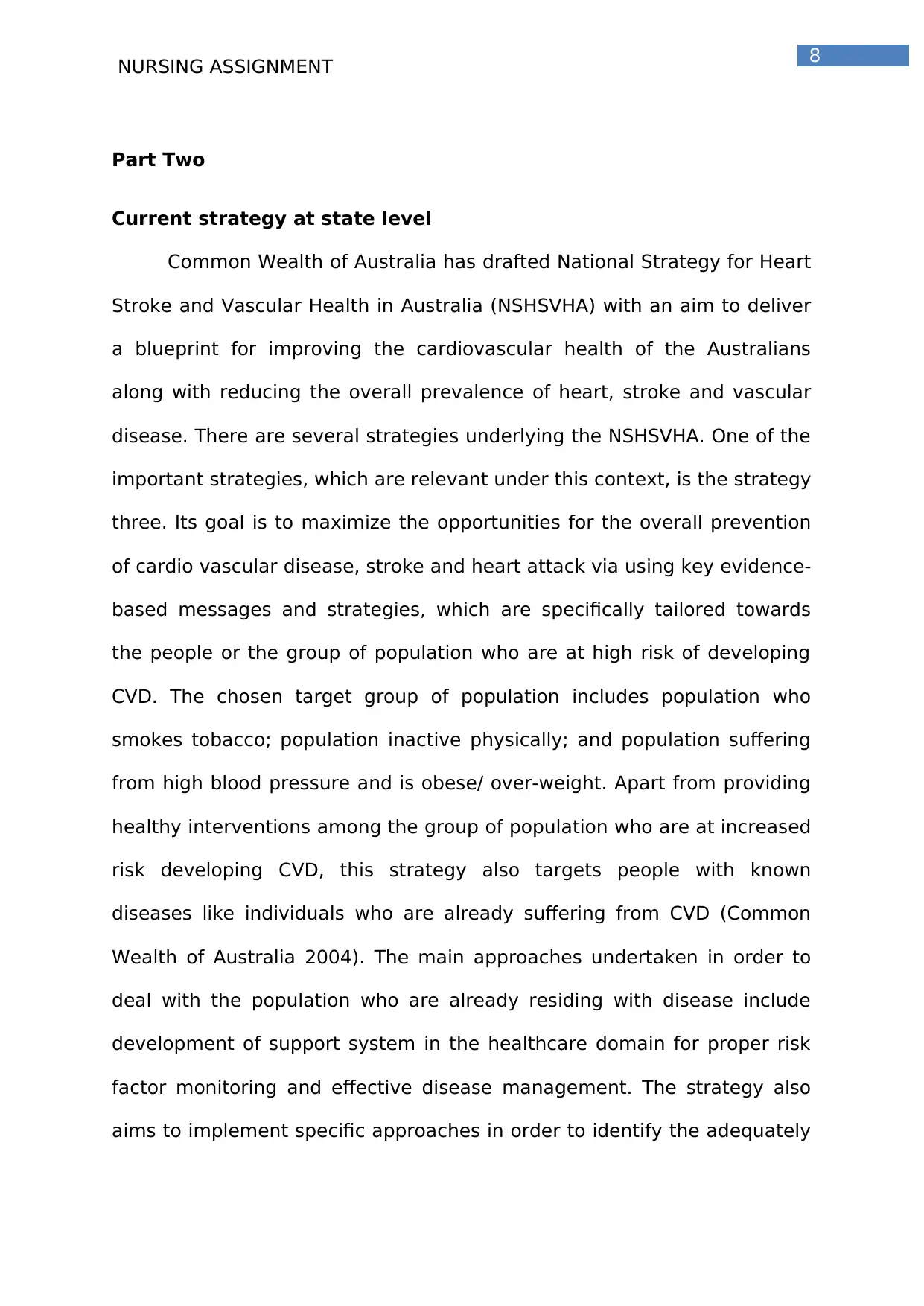
8
NURSING ASSIGNMENT
Part Two
Current strategy at state level
Common Wealth of Australia has drafted National Strategy for Heart
Stroke and Vascular Health in Australia (NSHSVHA) with an aim to deliver
a blueprint for improving the cardiovascular health of the Australians
along with reducing the overall prevalence of heart, stroke and vascular
disease. There are several strategies underlying the NSHSVHA. One of the
important strategies, which are relevant under this context, is the strategy
three. Its goal is to maximize the opportunities for the overall prevention
of cardio vascular disease, stroke and heart attack via using key evidence-
based messages and strategies, which are specifically tailored towards
the people or the group of population who are at high risk of developing
CVD. The chosen target group of population includes population who
smokes tobacco; population inactive physically; and population suffering
from high blood pressure and is obese/ over-weight. Apart from providing
healthy interventions among the group of population who are at increased
risk developing CVD, this strategy also targets people with known
diseases like individuals who are already suffering from CVD (Common
Wealth of Australia 2004). The main approaches undertaken in order to
deal with the population who are already residing with disease include
development of support system in the healthcare domain for proper risk
factor monitoring and effective disease management. The strategy also
aims to implement specific approaches in order to identify the adequately
NURSING ASSIGNMENT
Part Two
Current strategy at state level
Common Wealth of Australia has drafted National Strategy for Heart
Stroke and Vascular Health in Australia (NSHSVHA) with an aim to deliver
a blueprint for improving the cardiovascular health of the Australians
along with reducing the overall prevalence of heart, stroke and vascular
disease. There are several strategies underlying the NSHSVHA. One of the
important strategies, which are relevant under this context, is the strategy
three. Its goal is to maximize the opportunities for the overall prevention
of cardio vascular disease, stroke and heart attack via using key evidence-
based messages and strategies, which are specifically tailored towards
the people or the group of population who are at high risk of developing
CVD. The chosen target group of population includes population who
smokes tobacco; population inactive physically; and population suffering
from high blood pressure and is obese/ over-weight. Apart from providing
healthy interventions among the group of population who are at increased
risk developing CVD, this strategy also targets people with known
diseases like individuals who are already suffering from CVD (Common
Wealth of Australia 2004). The main approaches undertaken in order to
deal with the population who are already residing with disease include
development of support system in the healthcare domain for proper risk
factor monitoring and effective disease management. The strategy also
aims to implement specific approaches in order to identify the adequately
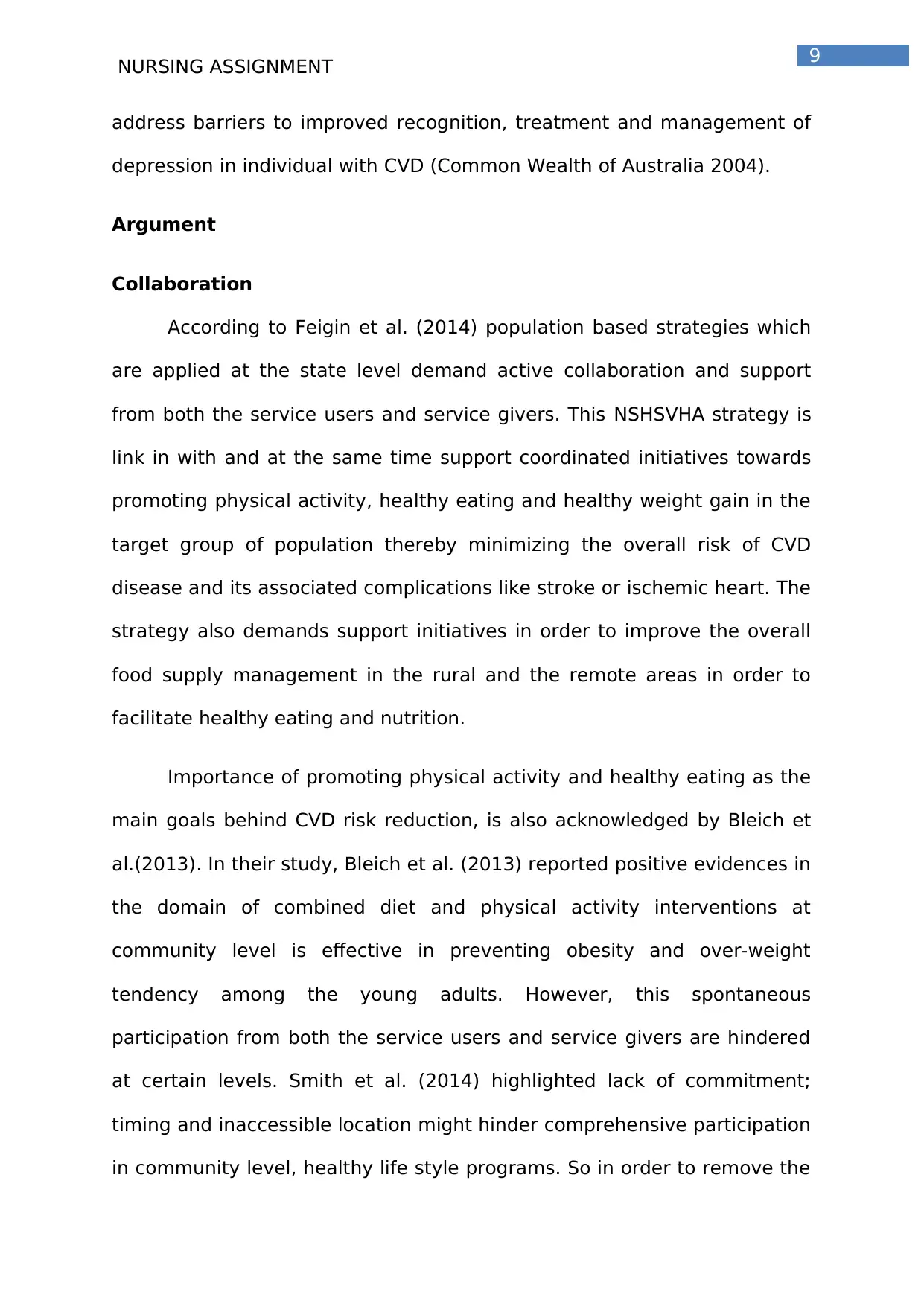
9
NURSING ASSIGNMENT
address barriers to improved recognition, treatment and management of
depression in individual with CVD (Common Wealth of Australia 2004).
Argument
Collaboration
According to Feigin et al. (2014) population based strategies which
are applied at the state level demand active collaboration and support
from both the service users and service givers. This NSHSVHA strategy is
link in with and at the same time support coordinated initiatives towards
promoting physical activity, healthy eating and healthy weight gain in the
target group of population thereby minimizing the overall risk of CVD
disease and its associated complications like stroke or ischemic heart. The
strategy also demands support initiatives in order to improve the overall
food supply management in the rural and the remote areas in order to
facilitate healthy eating and nutrition.
Importance of promoting physical activity and healthy eating as the
main goals behind CVD risk reduction, is also acknowledged by Bleich et
al.(2013). In their study, Bleich et al. (2013) reported positive evidences in
the domain of combined diet and physical activity interventions at
community level is effective in preventing obesity and over-weight
tendency among the young adults. However, this spontaneous
participation from both the service users and service givers are hindered
at certain levels. Smith et al. (2014) highlighted lack of commitment;
timing and inaccessible location might hinder comprehensive participation
in community level, healthy life style programs. So in order to remove the
NURSING ASSIGNMENT
address barriers to improved recognition, treatment and management of
depression in individual with CVD (Common Wealth of Australia 2004).
Argument
Collaboration
According to Feigin et al. (2014) population based strategies which
are applied at the state level demand active collaboration and support
from both the service users and service givers. This NSHSVHA strategy is
link in with and at the same time support coordinated initiatives towards
promoting physical activity, healthy eating and healthy weight gain in the
target group of population thereby minimizing the overall risk of CVD
disease and its associated complications like stroke or ischemic heart. The
strategy also demands support initiatives in order to improve the overall
food supply management in the rural and the remote areas in order to
facilitate healthy eating and nutrition.
Importance of promoting physical activity and healthy eating as the
main goals behind CVD risk reduction, is also acknowledged by Bleich et
al.(2013). In their study, Bleich et al. (2013) reported positive evidences in
the domain of combined diet and physical activity interventions at
community level is effective in preventing obesity and over-weight
tendency among the young adults. However, this spontaneous
participation from both the service users and service givers are hindered
at certain levels. Smith et al. (2014) highlighted lack of commitment;
timing and inaccessible location might hinder comprehensive participation
in community level, healthy life style programs. So in order to remove the
Secure Best Marks with AI Grader
Need help grading? Try our AI Grader for instant feedback on your assignments.
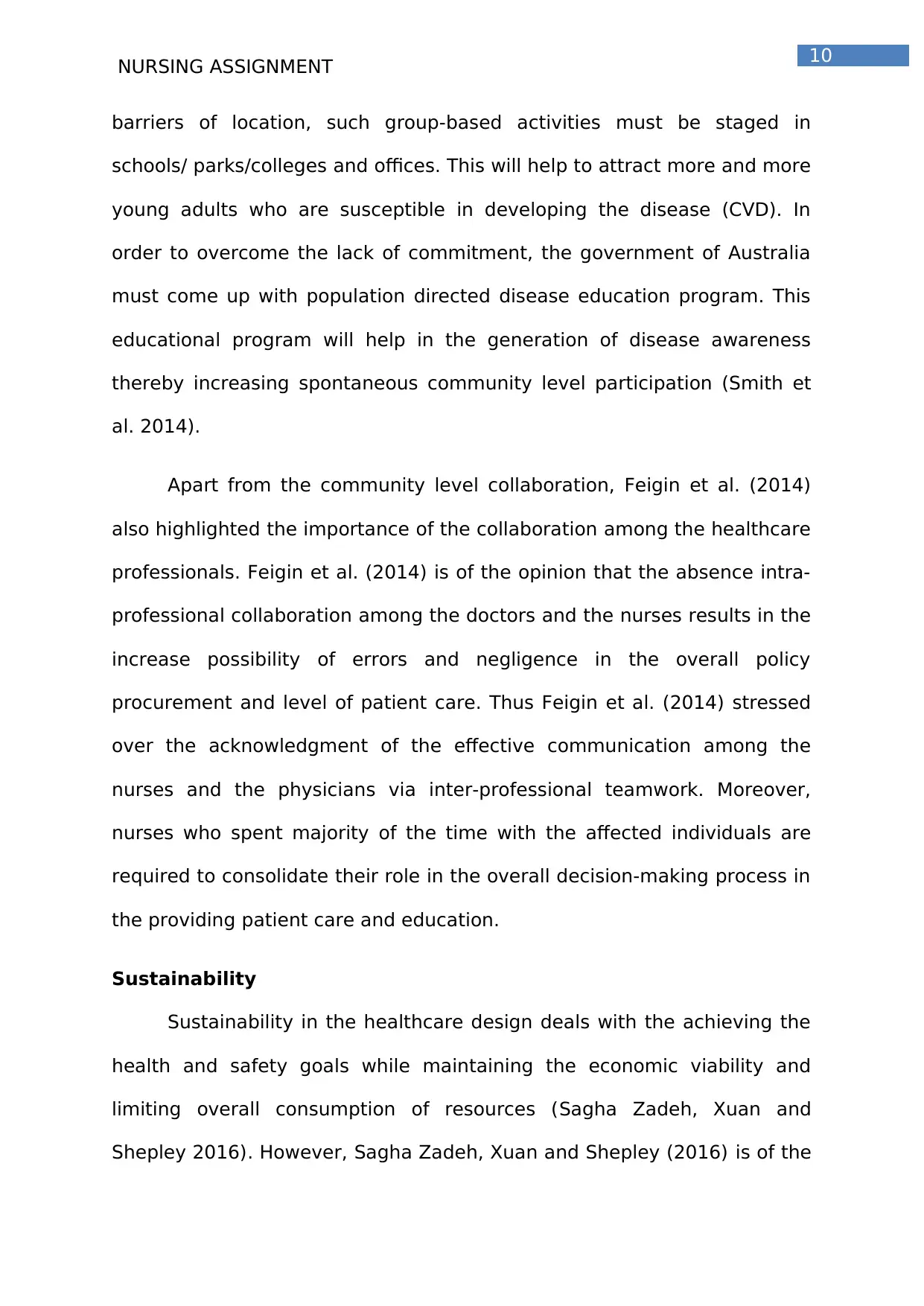
10
NURSING ASSIGNMENT
barriers of location, such group-based activities must be staged in
schools/ parks/colleges and offices. This will help to attract more and more
young adults who are susceptible in developing the disease (CVD). In
order to overcome the lack of commitment, the government of Australia
must come up with population directed disease education program. This
educational program will help in the generation of disease awareness
thereby increasing spontaneous community level participation (Smith et
al. 2014).
Apart from the community level collaboration, Feigin et al. (2014)
also highlighted the importance of the collaboration among the healthcare
professionals. Feigin et al. (2014) is of the opinion that the absence intra-
professional collaboration among the doctors and the nurses results in the
increase possibility of errors and negligence in the overall policy
procurement and level of patient care. Thus Feigin et al. (2014) stressed
over the acknowledgment of the effective communication among the
nurses and the physicians via inter-professional teamwork. Moreover,
nurses who spent majority of the time with the affected individuals are
required to consolidate their role in the overall decision-making process in
the providing patient care and education.
Sustainability
Sustainability in the healthcare design deals with the achieving the
health and safety goals while maintaining the economic viability and
limiting overall consumption of resources (Sagha Zadeh, Xuan and
Shepley 2016). However, Sagha Zadeh, Xuan and Shepley (2016) is of the
NURSING ASSIGNMENT
barriers of location, such group-based activities must be staged in
schools/ parks/colleges and offices. This will help to attract more and more
young adults who are susceptible in developing the disease (CVD). In
order to overcome the lack of commitment, the government of Australia
must come up with population directed disease education program. This
educational program will help in the generation of disease awareness
thereby increasing spontaneous community level participation (Smith et
al. 2014).
Apart from the community level collaboration, Feigin et al. (2014)
also highlighted the importance of the collaboration among the healthcare
professionals. Feigin et al. (2014) is of the opinion that the absence intra-
professional collaboration among the doctors and the nurses results in the
increase possibility of errors and negligence in the overall policy
procurement and level of patient care. Thus Feigin et al. (2014) stressed
over the acknowledgment of the effective communication among the
nurses and the physicians via inter-professional teamwork. Moreover,
nurses who spent majority of the time with the affected individuals are
required to consolidate their role in the overall decision-making process in
the providing patient care and education.
Sustainability
Sustainability in the healthcare design deals with the achieving the
health and safety goals while maintaining the economic viability and
limiting overall consumption of resources (Sagha Zadeh, Xuan and
Shepley 2016). However, Sagha Zadeh, Xuan and Shepley (2016) is of the
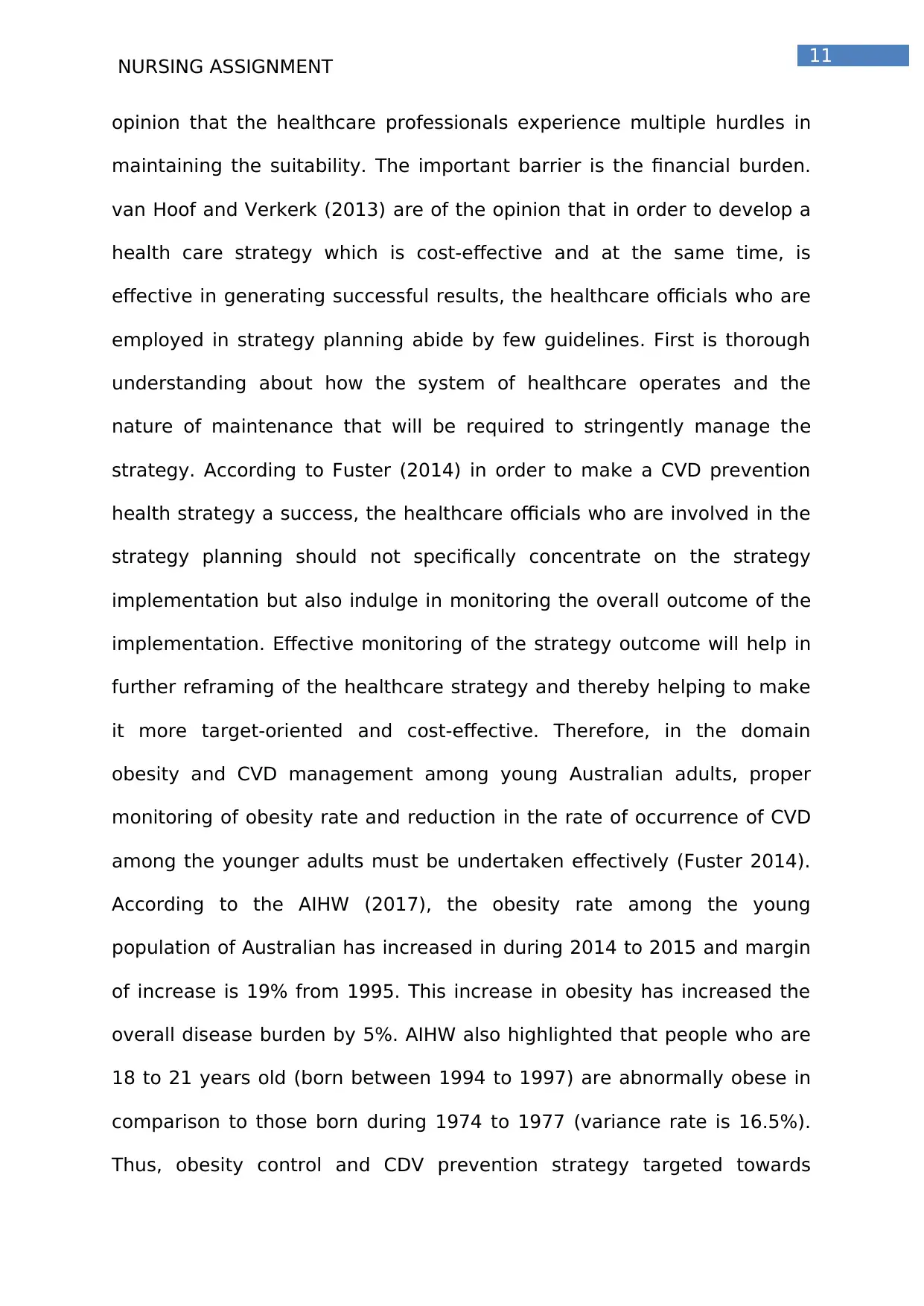
11
NURSING ASSIGNMENT
opinion that the healthcare professionals experience multiple hurdles in
maintaining the suitability. The important barrier is the financial burden.
van Hoof and Verkerk (2013) are of the opinion that in order to develop a
health care strategy which is cost-effective and at the same time, is
effective in generating successful results, the healthcare officials who are
employed in strategy planning abide by few guidelines. First is thorough
understanding about how the system of healthcare operates and the
nature of maintenance that will be required to stringently manage the
strategy. According to Fuster (2014) in order to make a CVD prevention
health strategy a success, the healthcare officials who are involved in the
strategy planning should not specifically concentrate on the strategy
implementation but also indulge in monitoring the overall outcome of the
implementation. Effective monitoring of the strategy outcome will help in
further reframing of the healthcare strategy and thereby helping to make
it more target-oriented and cost-effective. Therefore, in the domain
obesity and CVD management among young Australian adults, proper
monitoring of obesity rate and reduction in the rate of occurrence of CVD
among the younger adults must be undertaken effectively (Fuster 2014).
According to the AIHW (2017), the obesity rate among the young
population of Australian has increased in during 2014 to 2015 and margin
of increase is 19% from 1995. This increase in obesity has increased the
overall disease burden by 5%. AIHW also highlighted that people who are
18 to 21 years old (born between 1994 to 1997) are abnormally obese in
comparison to those born during 1974 to 1977 (variance rate is 16.5%).
Thus, obesity control and CDV prevention strategy targeted towards
NURSING ASSIGNMENT
opinion that the healthcare professionals experience multiple hurdles in
maintaining the suitability. The important barrier is the financial burden.
van Hoof and Verkerk (2013) are of the opinion that in order to develop a
health care strategy which is cost-effective and at the same time, is
effective in generating successful results, the healthcare officials who are
employed in strategy planning abide by few guidelines. First is thorough
understanding about how the system of healthcare operates and the
nature of maintenance that will be required to stringently manage the
strategy. According to Fuster (2014) in order to make a CVD prevention
health strategy a success, the healthcare officials who are involved in the
strategy planning should not specifically concentrate on the strategy
implementation but also indulge in monitoring the overall outcome of the
implementation. Effective monitoring of the strategy outcome will help in
further reframing of the healthcare strategy and thereby helping to make
it more target-oriented and cost-effective. Therefore, in the domain
obesity and CVD management among young Australian adults, proper
monitoring of obesity rate and reduction in the rate of occurrence of CVD
among the younger adults must be undertaken effectively (Fuster 2014).
According to the AIHW (2017), the obesity rate among the young
population of Australian has increased in during 2014 to 2015 and margin
of increase is 19% from 1995. This increase in obesity has increased the
overall disease burden by 5%. AIHW also highlighted that people who are
18 to 21 years old (born between 1994 to 1997) are abnormally obese in
comparison to those born during 1974 to 1977 (variance rate is 16.5%).
Thus, obesity control and CDV prevention strategy targeted towards
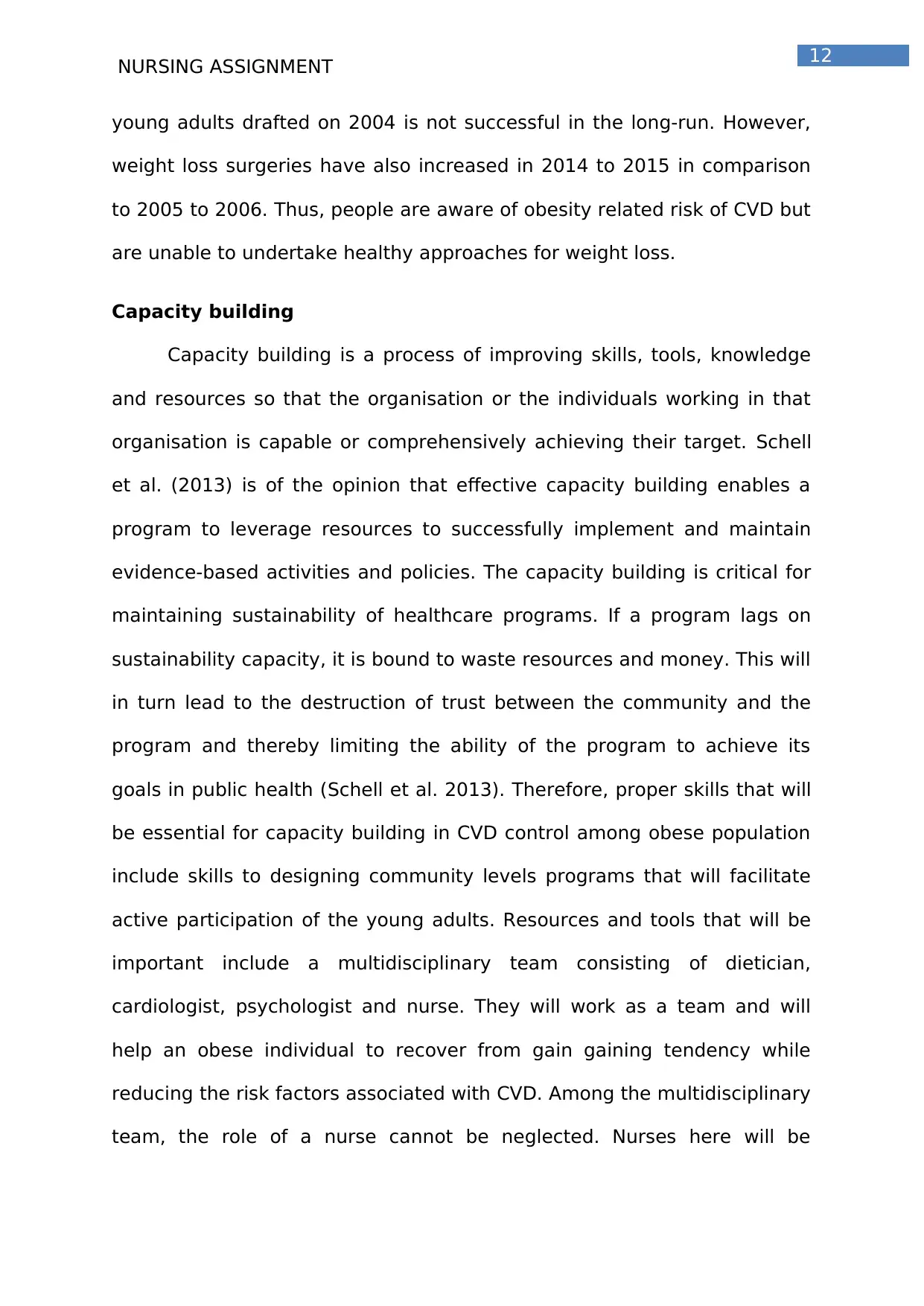
12
NURSING ASSIGNMENT
young adults drafted on 2004 is not successful in the long-run. However,
weight loss surgeries have also increased in 2014 to 2015 in comparison
to 2005 to 2006. Thus, people are aware of obesity related risk of CVD but
are unable to undertake healthy approaches for weight loss.
Capacity building
Capacity building is a process of improving skills, tools, knowledge
and resources so that the organisation or the individuals working in that
organisation is capable or comprehensively achieving their target. Schell
et al. (2013) is of the opinion that effective capacity building enables a
program to leverage resources to successfully implement and maintain
evidence-based activities and policies. The capacity building is critical for
maintaining sustainability of healthcare programs. If a program lags on
sustainability capacity, it is bound to waste resources and money. This will
in turn lead to the destruction of trust between the community and the
program and thereby limiting the ability of the program to achieve its
goals in public health (Schell et al. 2013). Therefore, proper skills that will
be essential for capacity building in CVD control among obese population
include skills to designing community levels programs that will facilitate
active participation of the young adults. Resources and tools that will be
important include a multidisciplinary team consisting of dietician,
cardiologist, psychologist and nurse. They will work as a team and will
help an obese individual to recover from gain gaining tendency while
reducing the risk factors associated with CVD. Among the multidisciplinary
team, the role of a nurse cannot be neglected. Nurses here will be
NURSING ASSIGNMENT
young adults drafted on 2004 is not successful in the long-run. However,
weight loss surgeries have also increased in 2014 to 2015 in comparison
to 2005 to 2006. Thus, people are aware of obesity related risk of CVD but
are unable to undertake healthy approaches for weight loss.
Capacity building
Capacity building is a process of improving skills, tools, knowledge
and resources so that the organisation or the individuals working in that
organisation is capable or comprehensively achieving their target. Schell
et al. (2013) is of the opinion that effective capacity building enables a
program to leverage resources to successfully implement and maintain
evidence-based activities and policies. The capacity building is critical for
maintaining sustainability of healthcare programs. If a program lags on
sustainability capacity, it is bound to waste resources and money. This will
in turn lead to the destruction of trust between the community and the
program and thereby limiting the ability of the program to achieve its
goals in public health (Schell et al. 2013). Therefore, proper skills that will
be essential for capacity building in CVD control among obese population
include skills to designing community levels programs that will facilitate
active participation of the young adults. Resources and tools that will be
important include a multidisciplinary team consisting of dietician,
cardiologist, psychologist and nurse. They will work as a team and will
help an obese individual to recover from gain gaining tendency while
reducing the risk factors associated with CVD. Among the multidisciplinary
team, the role of a nurse cannot be neglected. Nurses here will be
Paraphrase This Document
Need a fresh take? Get an instant paraphrase of this document with our AI Paraphraser
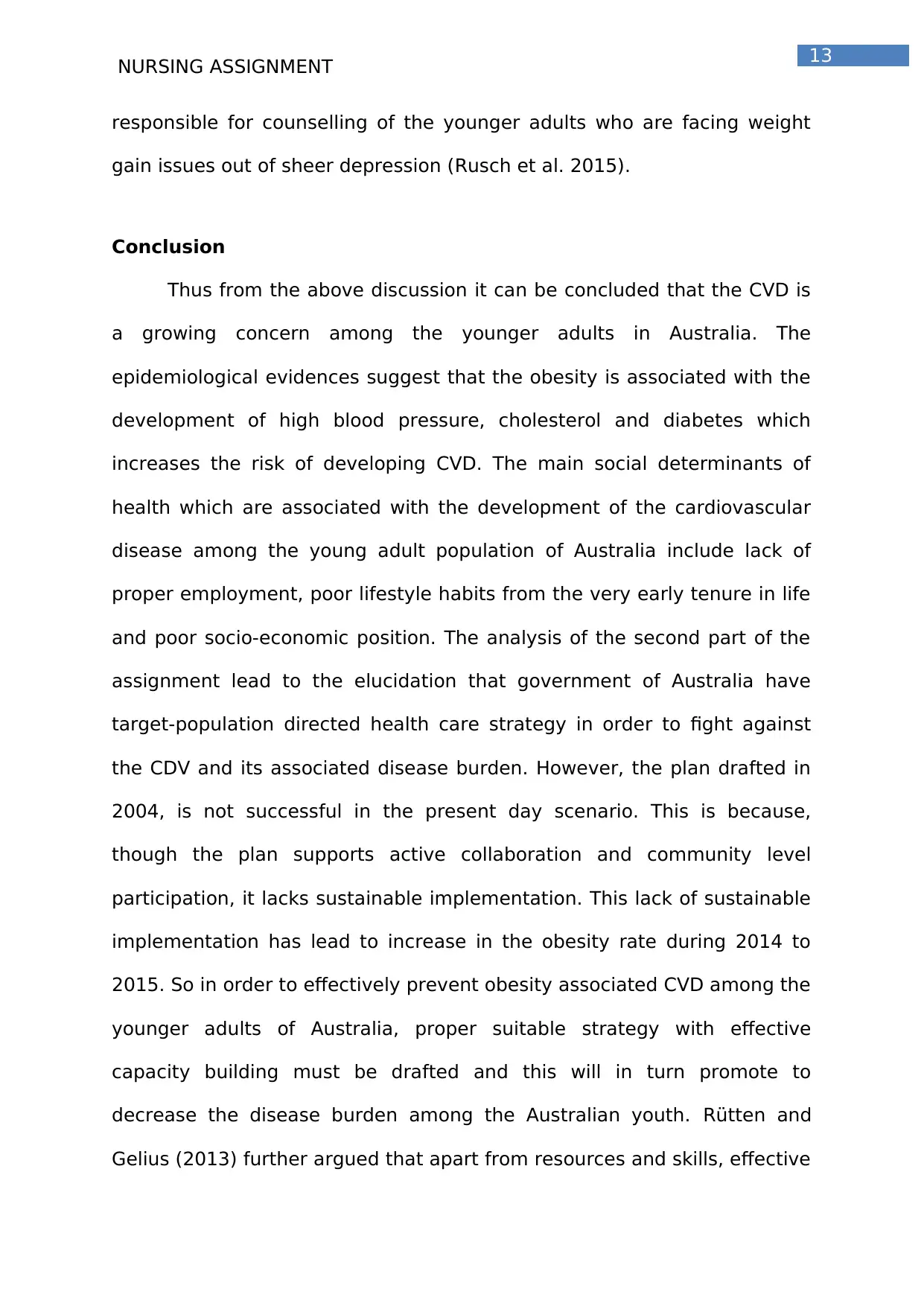
13
NURSING ASSIGNMENT
responsible for counselling of the younger adults who are facing weight
gain issues out of sheer depression (Rusch et al. 2015).
Conclusion
Thus from the above discussion it can be concluded that the CVD is
a growing concern among the younger adults in Australia. The
epidemiological evidences suggest that the obesity is associated with the
development of high blood pressure, cholesterol and diabetes which
increases the risk of developing CVD. The main social determinants of
health which are associated with the development of the cardiovascular
disease among the young adult population of Australia include lack of
proper employment, poor lifestyle habits from the very early tenure in life
and poor socio-economic position. The analysis of the second part of the
assignment lead to the elucidation that government of Australia have
target-population directed health care strategy in order to fight against
the CDV and its associated disease burden. However, the plan drafted in
2004, is not successful in the present day scenario. This is because,
though the plan supports active collaboration and community level
participation, it lacks sustainable implementation. This lack of sustainable
implementation has lead to increase in the obesity rate during 2014 to
2015. So in order to effectively prevent obesity associated CVD among the
younger adults of Australia, proper suitable strategy with effective
capacity building must be drafted and this will in turn promote to
decrease the disease burden among the Australian youth. Rütten and
Gelius (2013) further argued that apart from resources and skills, effective
NURSING ASSIGNMENT
responsible for counselling of the younger adults who are facing weight
gain issues out of sheer depression (Rusch et al. 2015).
Conclusion
Thus from the above discussion it can be concluded that the CVD is
a growing concern among the younger adults in Australia. The
epidemiological evidences suggest that the obesity is associated with the
development of high blood pressure, cholesterol and diabetes which
increases the risk of developing CVD. The main social determinants of
health which are associated with the development of the cardiovascular
disease among the young adult population of Australia include lack of
proper employment, poor lifestyle habits from the very early tenure in life
and poor socio-economic position. The analysis of the second part of the
assignment lead to the elucidation that government of Australia have
target-population directed health care strategy in order to fight against
the CDV and its associated disease burden. However, the plan drafted in
2004, is not successful in the present day scenario. This is because,
though the plan supports active collaboration and community level
participation, it lacks sustainable implementation. This lack of sustainable
implementation has lead to increase in the obesity rate during 2014 to
2015. So in order to effectively prevent obesity associated CVD among the
younger adults of Australia, proper suitable strategy with effective
capacity building must be drafted and this will in turn promote to
decrease the disease burden among the Australian youth. Rütten and
Gelius (2013) further argued that apart from resources and skills, effective

14
NURSING ASSIGNMENT
capacity building of healthcare policy must encompass an interactive
approach. This will help to link knowledge to action towards the process of
health promotion.
NURSING ASSIGNMENT
capacity building of healthcare policy must encompass an interactive
approach. This will help to link knowledge to action towards the process of
health promotion.
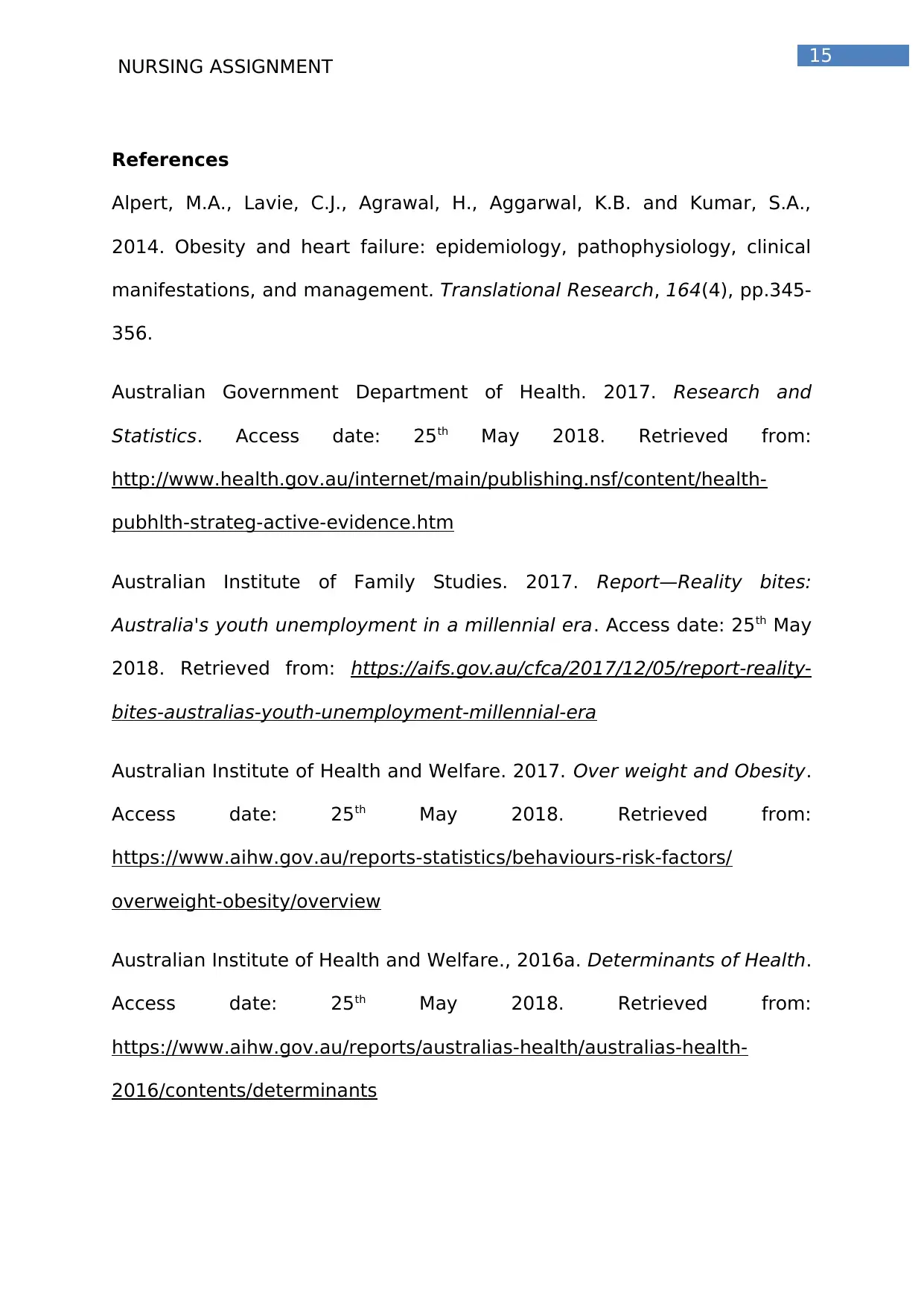
15
NURSING ASSIGNMENT
References
Alpert, M.A., Lavie, C.J., Agrawal, H., Aggarwal, K.B. and Kumar, S.A.,
2014. Obesity and heart failure: epidemiology, pathophysiology, clinical
manifestations, and management. Translational Research, 164(4), pp.345-
356.
Australian Government Department of Health. 2017. Research and
Statistics. Access date: 25th May 2018. Retrieved from:
http://www.health.gov.au/internet/main/publishing.nsf/content/health-
pubhlth-strateg-active-evidence.htm
Australian Institute of Family Studies. 2017. Report—Reality bites:
Australia's youth unemployment in a millennial era. Access date: 25th May
2018. Retrieved from: https://aifs.gov.au/cfca/2017/12/05/report-reality-
bites-australias-youth-unemployment-millennial-era
Australian Institute of Health and Welfare. 2017. Over weight and Obesity.
Access date: 25th May 2018. Retrieved from:
https://www.aihw.gov.au/reports-statistics/behaviours-risk-factors/
overweight-obesity/overview
Australian Institute of Health and Welfare., 2016a. Determinants of Health.
Access date: 25th May 2018. Retrieved from:
https://www.aihw.gov.au/reports/australias-health/australias-health-
2016/contents/determinants
NURSING ASSIGNMENT
References
Alpert, M.A., Lavie, C.J., Agrawal, H., Aggarwal, K.B. and Kumar, S.A.,
2014. Obesity and heart failure: epidemiology, pathophysiology, clinical
manifestations, and management. Translational Research, 164(4), pp.345-
356.
Australian Government Department of Health. 2017. Research and
Statistics. Access date: 25th May 2018. Retrieved from:
http://www.health.gov.au/internet/main/publishing.nsf/content/health-
pubhlth-strateg-active-evidence.htm
Australian Institute of Family Studies. 2017. Report—Reality bites:
Australia's youth unemployment in a millennial era. Access date: 25th May
2018. Retrieved from: https://aifs.gov.au/cfca/2017/12/05/report-reality-
bites-australias-youth-unemployment-millennial-era
Australian Institute of Health and Welfare. 2017. Over weight and Obesity.
Access date: 25th May 2018. Retrieved from:
https://www.aihw.gov.au/reports-statistics/behaviours-risk-factors/
overweight-obesity/overview
Australian Institute of Health and Welfare., 2016a. Determinants of Health.
Access date: 25th May 2018. Retrieved from:
https://www.aihw.gov.au/reports/australias-health/australias-health-
2016/contents/determinants
Secure Best Marks with AI Grader
Need help grading? Try our AI Grader for instant feedback on your assignments.
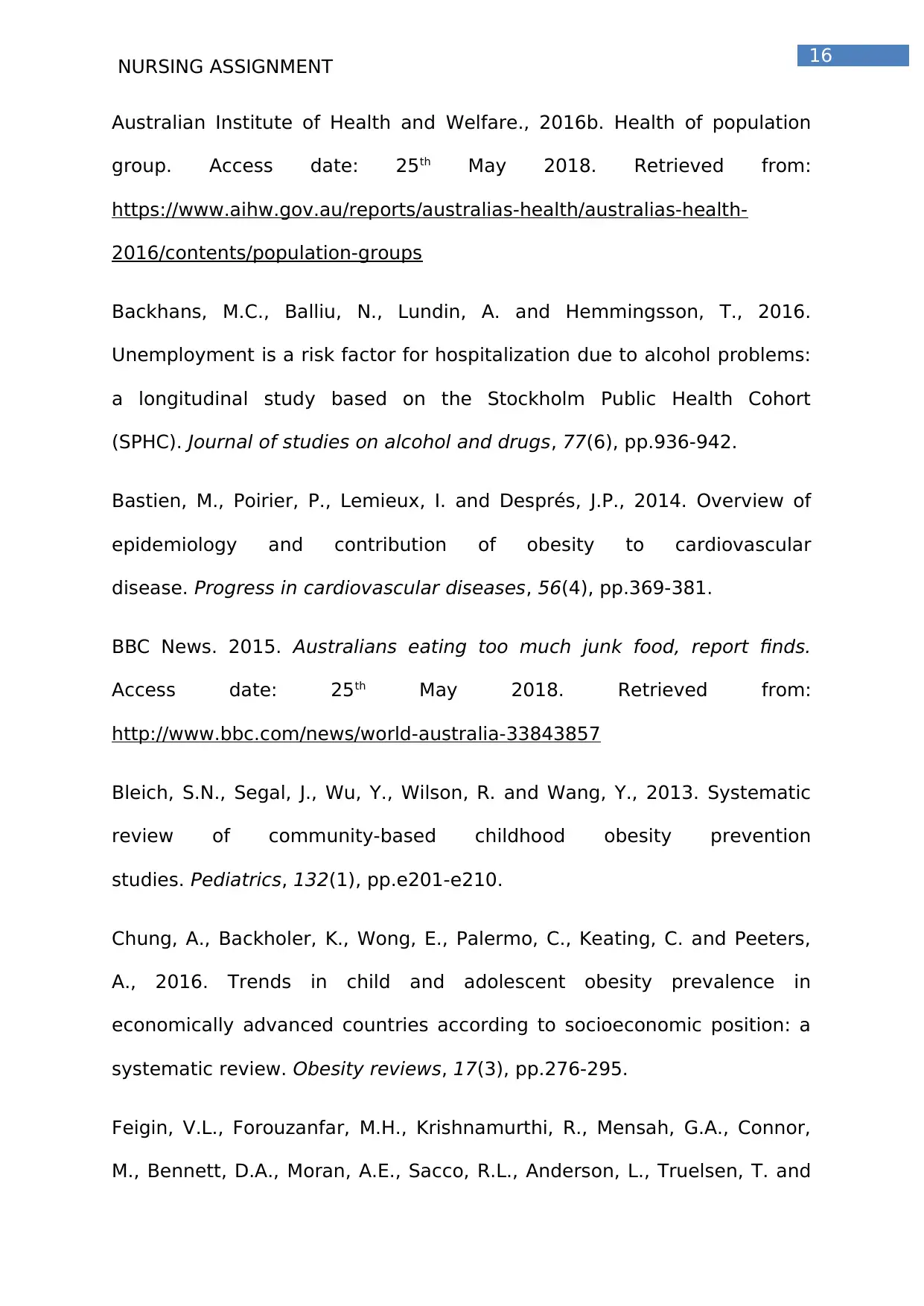
16
NURSING ASSIGNMENT
Australian Institute of Health and Welfare., 2016b. Health of population
group. Access date: 25th May 2018. Retrieved from:
https://www.aihw.gov.au/reports/australias-health/australias-health-
2016/contents/population-groups
Backhans, M.C., Balliu, N., Lundin, A. and Hemmingsson, T., 2016.
Unemployment is a risk factor for hospitalization due to alcohol problems:
a longitudinal study based on the Stockholm Public Health Cohort
(SPHC). Journal of studies on alcohol and drugs, 77(6), pp.936-942.
Bastien, M., Poirier, P., Lemieux, I. and Després, J.P., 2014. Overview of
epidemiology and contribution of obesity to cardiovascular
disease. Progress in cardiovascular diseases, 56(4), pp.369-381.
BBC News. 2015. Australians eating too much junk food, report finds.
Access date: 25th May 2018. Retrieved from:
http://www.bbc.com/news/world-australia-33843857
Bleich, S.N., Segal, J., Wu, Y., Wilson, R. and Wang, Y., 2013. Systematic
review of community-based childhood obesity prevention
studies. Pediatrics, 132(1), pp.e201-e210.
Chung, A., Backholer, K., Wong, E., Palermo, C., Keating, C. and Peeters,
A., 2016. Trends in child and adolescent obesity prevalence in
economically advanced countries according to socioeconomic position: a
systematic review. Obesity reviews, 17(3), pp.276-295.
Feigin, V.L., Forouzanfar, M.H., Krishnamurthi, R., Mensah, G.A., Connor,
M., Bennett, D.A., Moran, A.E., Sacco, R.L., Anderson, L., Truelsen, T. and
NURSING ASSIGNMENT
Australian Institute of Health and Welfare., 2016b. Health of population
group. Access date: 25th May 2018. Retrieved from:
https://www.aihw.gov.au/reports/australias-health/australias-health-
2016/contents/population-groups
Backhans, M.C., Balliu, N., Lundin, A. and Hemmingsson, T., 2016.
Unemployment is a risk factor for hospitalization due to alcohol problems:
a longitudinal study based on the Stockholm Public Health Cohort
(SPHC). Journal of studies on alcohol and drugs, 77(6), pp.936-942.
Bastien, M., Poirier, P., Lemieux, I. and Després, J.P., 2014. Overview of
epidemiology and contribution of obesity to cardiovascular
disease. Progress in cardiovascular diseases, 56(4), pp.369-381.
BBC News. 2015. Australians eating too much junk food, report finds.
Access date: 25th May 2018. Retrieved from:
http://www.bbc.com/news/world-australia-33843857
Bleich, S.N., Segal, J., Wu, Y., Wilson, R. and Wang, Y., 2013. Systematic
review of community-based childhood obesity prevention
studies. Pediatrics, 132(1), pp.e201-e210.
Chung, A., Backholer, K., Wong, E., Palermo, C., Keating, C. and Peeters,
A., 2016. Trends in child and adolescent obesity prevalence in
economically advanced countries according to socioeconomic position: a
systematic review. Obesity reviews, 17(3), pp.276-295.
Feigin, V.L., Forouzanfar, M.H., Krishnamurthi, R., Mensah, G.A., Connor,
M., Bennett, D.A., Moran, A.E., Sacco, R.L., Anderson, L., Truelsen, T. and
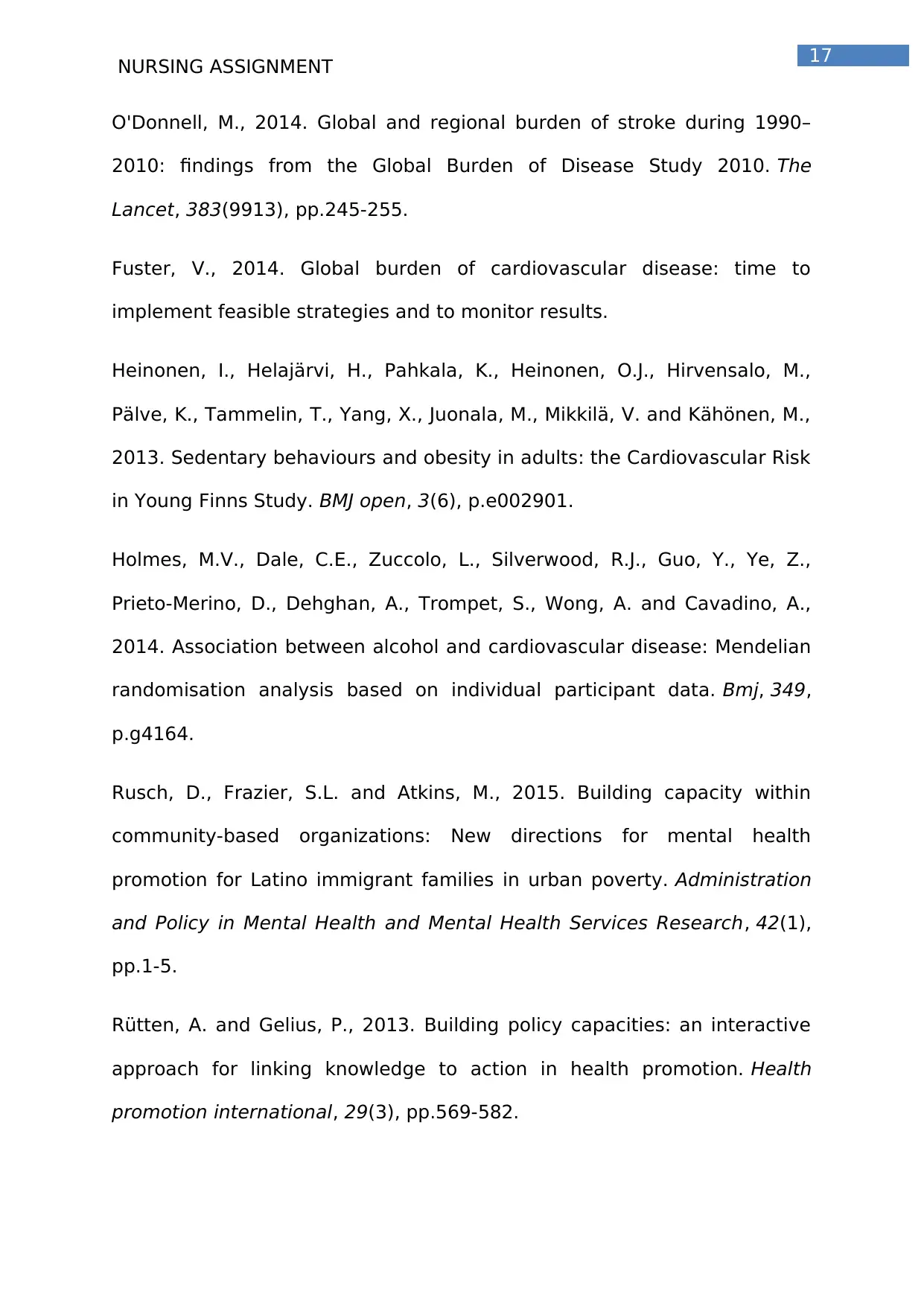
17
NURSING ASSIGNMENT
O'Donnell, M., 2014. Global and regional burden of stroke during 1990–
2010: findings from the Global Burden of Disease Study 2010. The
Lancet, 383(9913), pp.245-255.
Fuster, V., 2014. Global burden of cardiovascular disease: time to
implement feasible strategies and to monitor results.
Heinonen, I., Helajärvi, H., Pahkala, K., Heinonen, O.J., Hirvensalo, M.,
Pälve, K., Tammelin, T., Yang, X., Juonala, M., Mikkilä, V. and Kähönen, M.,
2013. Sedentary behaviours and obesity in adults: the Cardiovascular Risk
in Young Finns Study. BMJ open, 3(6), p.e002901.
Holmes, M.V., Dale, C.E., Zuccolo, L., Silverwood, R.J., Guo, Y., Ye, Z.,
Prieto-Merino, D., Dehghan, A., Trompet, S., Wong, A. and Cavadino, A.,
2014. Association between alcohol and cardiovascular disease: Mendelian
randomisation analysis based on individual participant data. Bmj, 349,
p.g4164.
Rusch, D., Frazier, S.L. and Atkins, M., 2015. Building capacity within
community-based organizations: New directions for mental health
promotion for Latino immigrant families in urban poverty. Administration
and Policy in Mental Health and Mental Health Services Research, 42(1),
pp.1-5.
Rütten, A. and Gelius, P., 2013. Building policy capacities: an interactive
approach for linking knowledge to action in health promotion. Health
promotion international, 29(3), pp.569-582.
NURSING ASSIGNMENT
O'Donnell, M., 2014. Global and regional burden of stroke during 1990–
2010: findings from the Global Burden of Disease Study 2010. The
Lancet, 383(9913), pp.245-255.
Fuster, V., 2014. Global burden of cardiovascular disease: time to
implement feasible strategies and to monitor results.
Heinonen, I., Helajärvi, H., Pahkala, K., Heinonen, O.J., Hirvensalo, M.,
Pälve, K., Tammelin, T., Yang, X., Juonala, M., Mikkilä, V. and Kähönen, M.,
2013. Sedentary behaviours and obesity in adults: the Cardiovascular Risk
in Young Finns Study. BMJ open, 3(6), p.e002901.
Holmes, M.V., Dale, C.E., Zuccolo, L., Silverwood, R.J., Guo, Y., Ye, Z.,
Prieto-Merino, D., Dehghan, A., Trompet, S., Wong, A. and Cavadino, A.,
2014. Association between alcohol and cardiovascular disease: Mendelian
randomisation analysis based on individual participant data. Bmj, 349,
p.g4164.
Rusch, D., Frazier, S.L. and Atkins, M., 2015. Building capacity within
community-based organizations: New directions for mental health
promotion for Latino immigrant families in urban poverty. Administration
and Policy in Mental Health and Mental Health Services Research, 42(1),
pp.1-5.
Rütten, A. and Gelius, P., 2013. Building policy capacities: an interactive
approach for linking knowledge to action in health promotion. Health
promotion international, 29(3), pp.569-582.
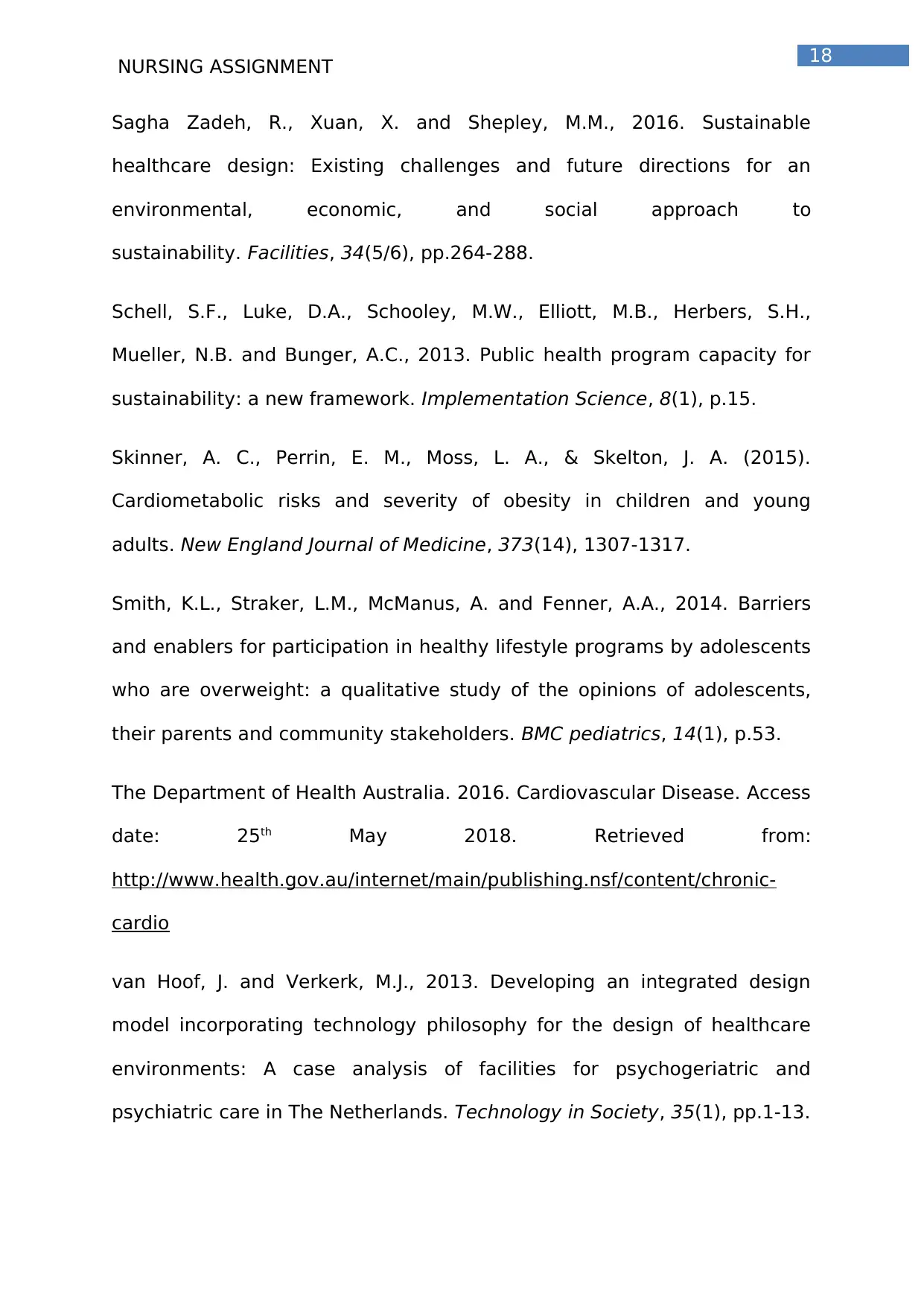
18
NURSING ASSIGNMENT
Sagha Zadeh, R., Xuan, X. and Shepley, M.M., 2016. Sustainable
healthcare design: Existing challenges and future directions for an
environmental, economic, and social approach to
sustainability. Facilities, 34(5/6), pp.264-288.
Schell, S.F., Luke, D.A., Schooley, M.W., Elliott, M.B., Herbers, S.H.,
Mueller, N.B. and Bunger, A.C., 2013. Public health program capacity for
sustainability: a new framework. Implementation Science, 8(1), p.15.
Skinner, A. C., Perrin, E. M., Moss, L. A., & Skelton, J. A. (2015).
Cardiometabolic risks and severity of obesity in children and young
adults. New England Journal of Medicine, 373(14), 1307-1317.
Smith, K.L., Straker, L.M., McManus, A. and Fenner, A.A., 2014. Barriers
and enablers for participation in healthy lifestyle programs by adolescents
who are overweight: a qualitative study of the opinions of adolescents,
their parents and community stakeholders. BMC pediatrics, 14(1), p.53.
The Department of Health Australia. 2016. Cardiovascular Disease. Access
date: 25th May 2018. Retrieved from:
http://www.health.gov.au/internet/main/publishing.nsf/content/chronic-
cardio
van Hoof, J. and Verkerk, M.J., 2013. Developing an integrated design
model incorporating technology philosophy for the design of healthcare
environments: A case analysis of facilities for psychogeriatric and
psychiatric care in The Netherlands. Technology in Society, 35(1), pp.1-13.
NURSING ASSIGNMENT
Sagha Zadeh, R., Xuan, X. and Shepley, M.M., 2016. Sustainable
healthcare design: Existing challenges and future directions for an
environmental, economic, and social approach to
sustainability. Facilities, 34(5/6), pp.264-288.
Schell, S.F., Luke, D.A., Schooley, M.W., Elliott, M.B., Herbers, S.H.,
Mueller, N.B. and Bunger, A.C., 2013. Public health program capacity for
sustainability: a new framework. Implementation Science, 8(1), p.15.
Skinner, A. C., Perrin, E. M., Moss, L. A., & Skelton, J. A. (2015).
Cardiometabolic risks and severity of obesity in children and young
adults. New England Journal of Medicine, 373(14), 1307-1317.
Smith, K.L., Straker, L.M., McManus, A. and Fenner, A.A., 2014. Barriers
and enablers for participation in healthy lifestyle programs by adolescents
who are overweight: a qualitative study of the opinions of adolescents,
their parents and community stakeholders. BMC pediatrics, 14(1), p.53.
The Department of Health Australia. 2016. Cardiovascular Disease. Access
date: 25th May 2018. Retrieved from:
http://www.health.gov.au/internet/main/publishing.nsf/content/chronic-
cardio
van Hoof, J. and Verkerk, M.J., 2013. Developing an integrated design
model incorporating technology philosophy for the design of healthcare
environments: A case analysis of facilities for psychogeriatric and
psychiatric care in The Netherlands. Technology in Society, 35(1), pp.1-13.
Paraphrase This Document
Need a fresh take? Get an instant paraphrase of this document with our AI Paraphraser

19
NURSING ASSIGNMENT
Waters, A.M., Trinh, L., Chau, T., Bourchier, M. and Moon, L., 2013. Latest
statistics on cardiovascular disease in Australia. Clinical and Experimental
Pharmacology and Physiology, 40(6), pp.347-356.
NURSING ASSIGNMENT
Waters, A.M., Trinh, L., Chau, T., Bourchier, M. and Moon, L., 2013. Latest
statistics on cardiovascular disease in Australia. Clinical and Experimental
Pharmacology and Physiology, 40(6), pp.347-356.
1 out of 20
Related Documents
Your All-in-One AI-Powered Toolkit for Academic Success.
+13062052269
info@desklib.com
Available 24*7 on WhatsApp / Email
![[object Object]](/_next/static/media/star-bottom.7253800d.svg)
Unlock your academic potential
© 2024 | Zucol Services PVT LTD | All rights reserved.





